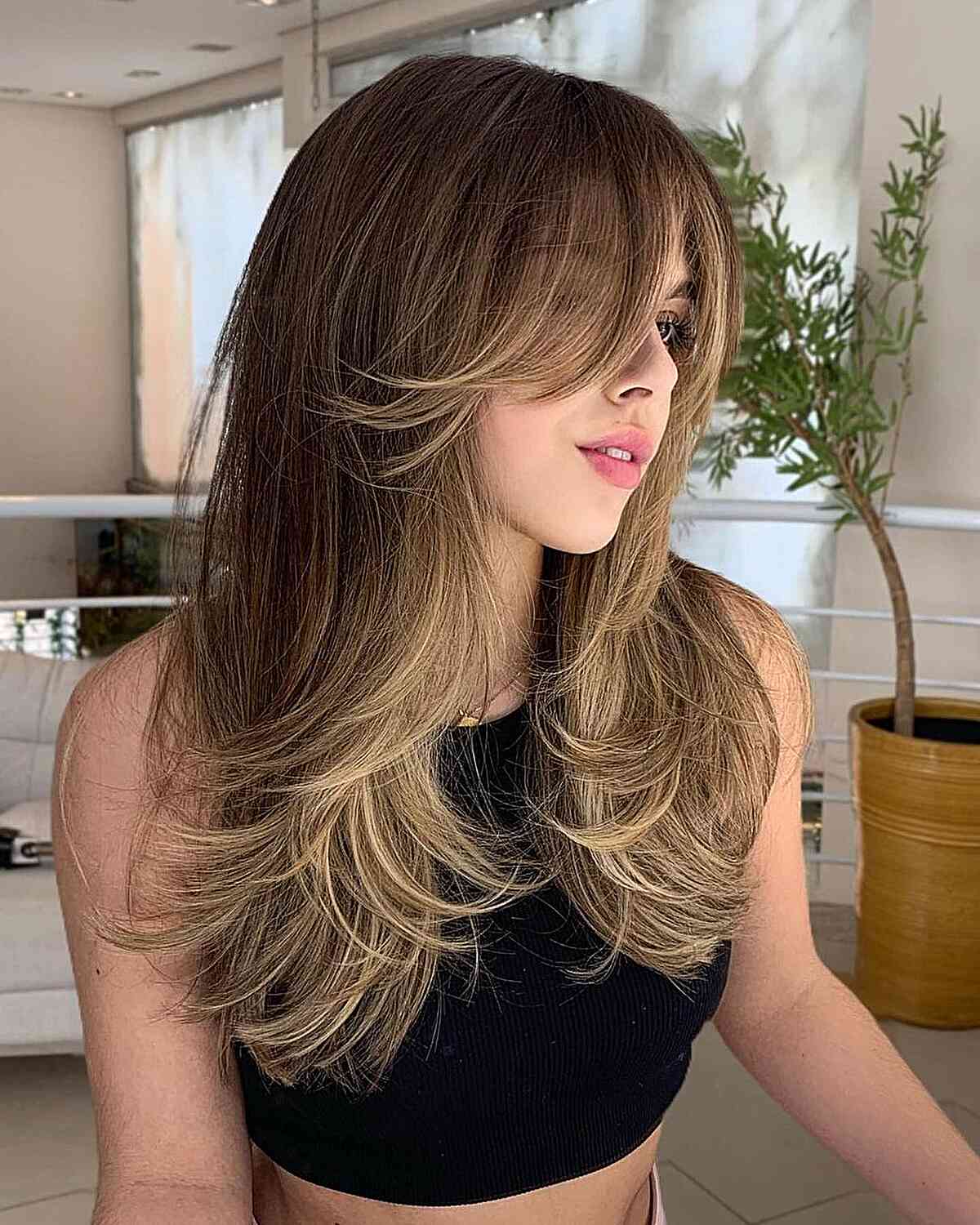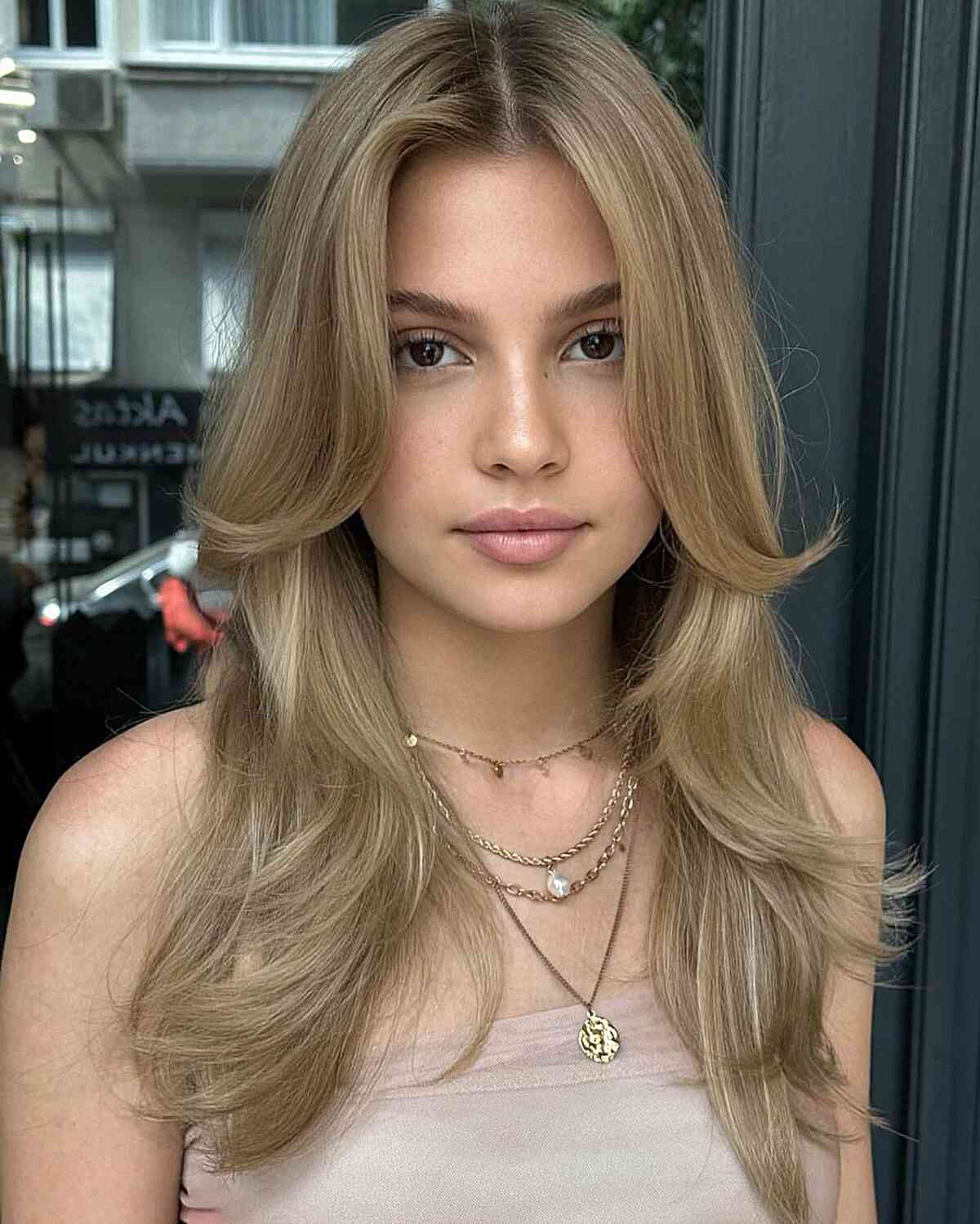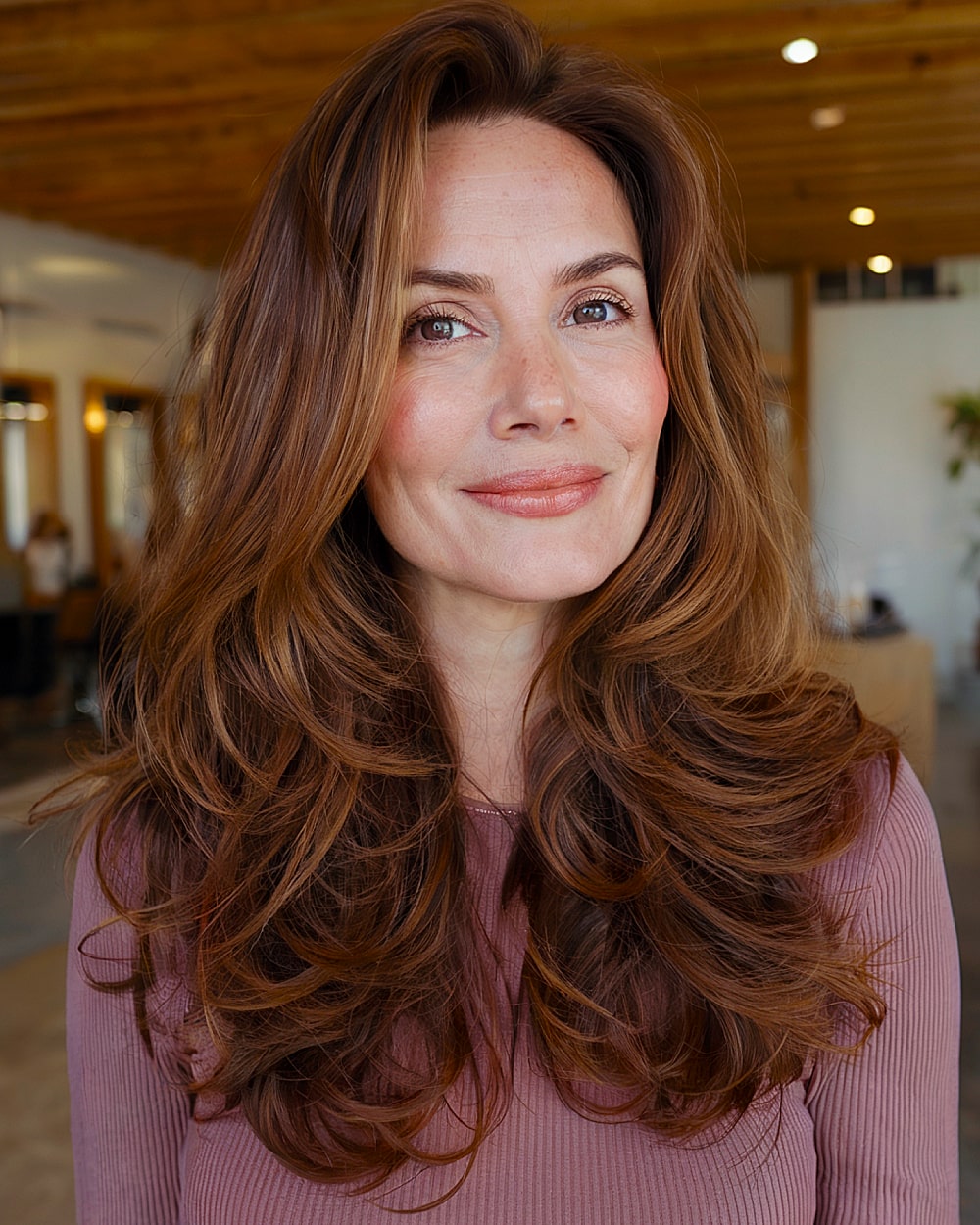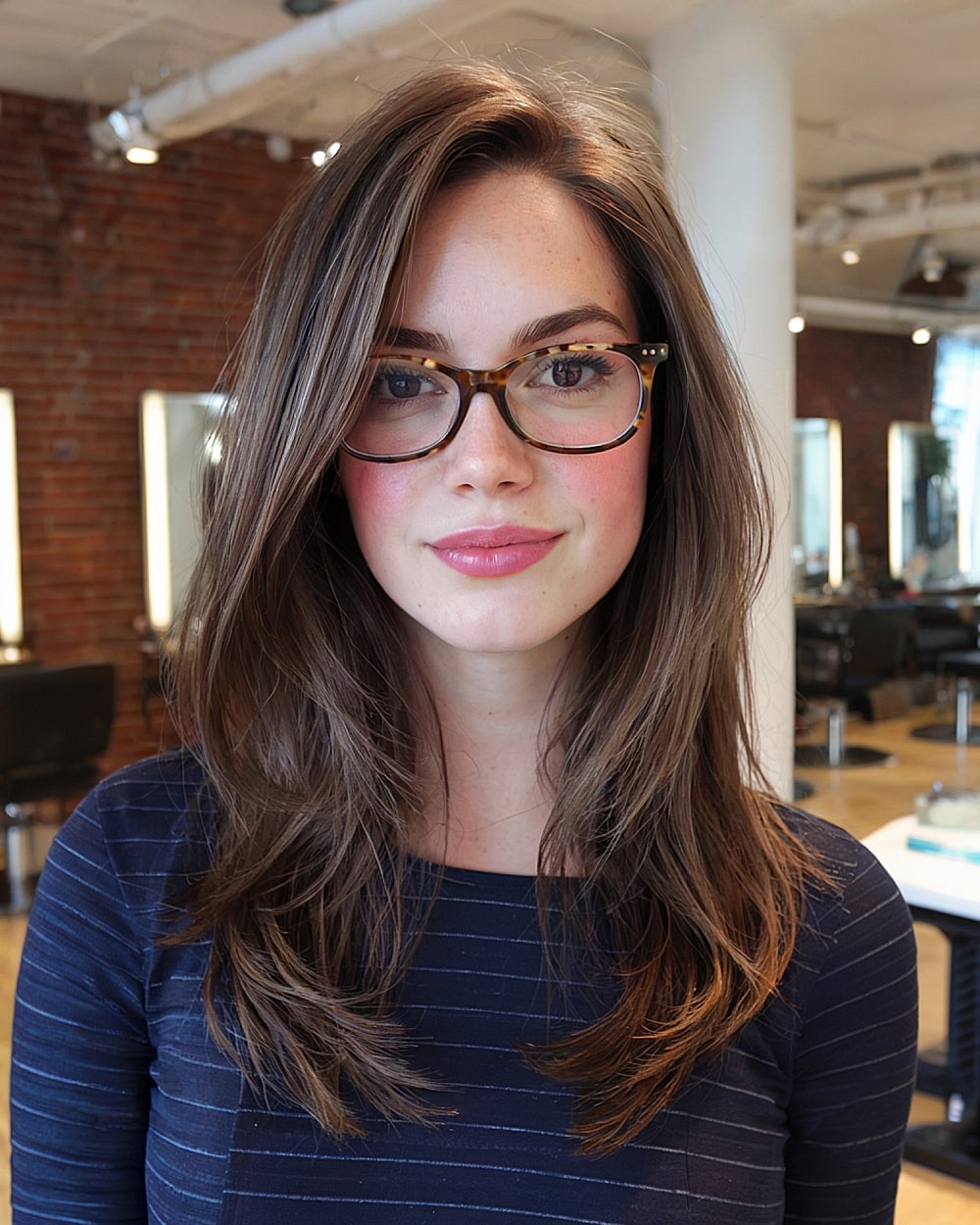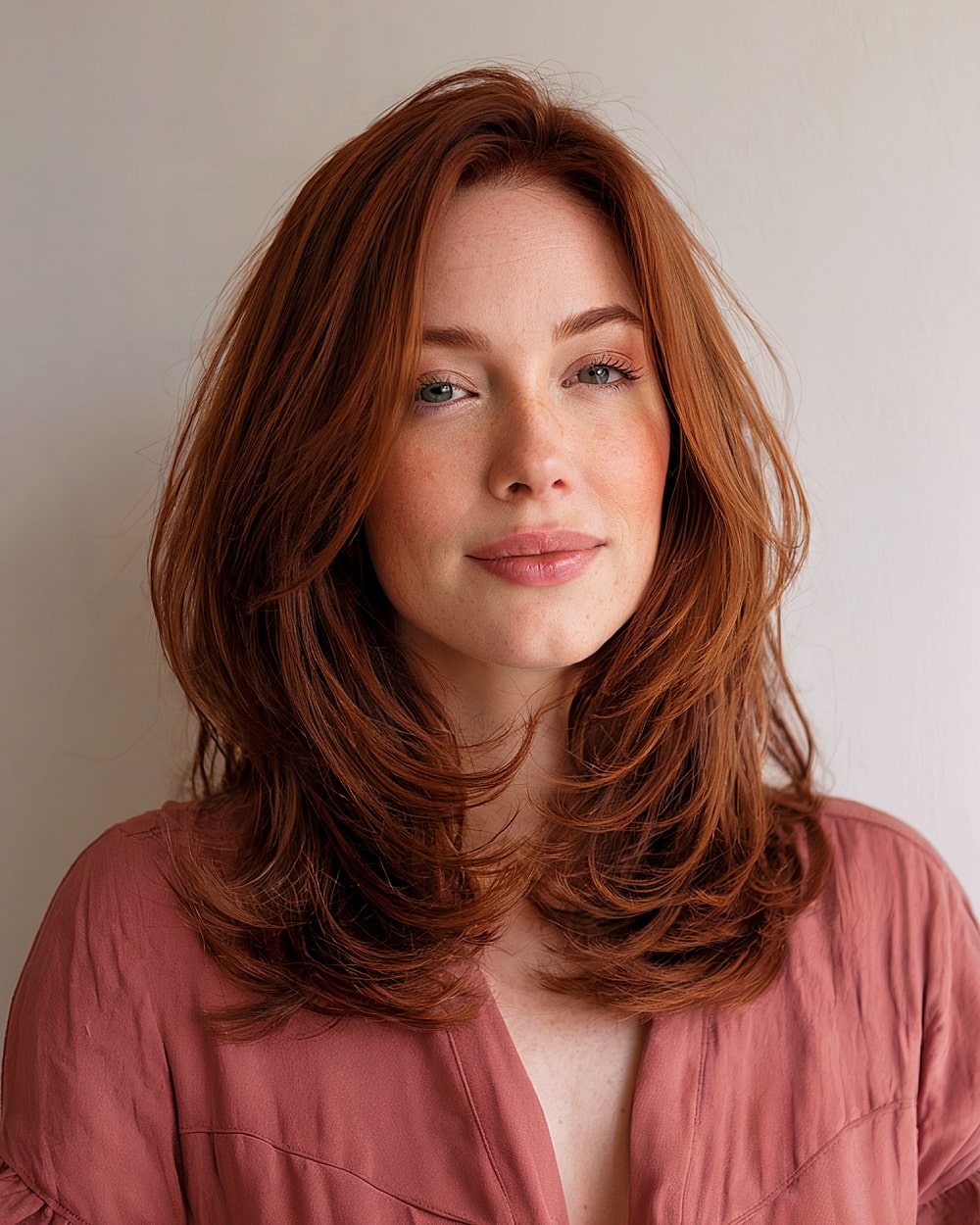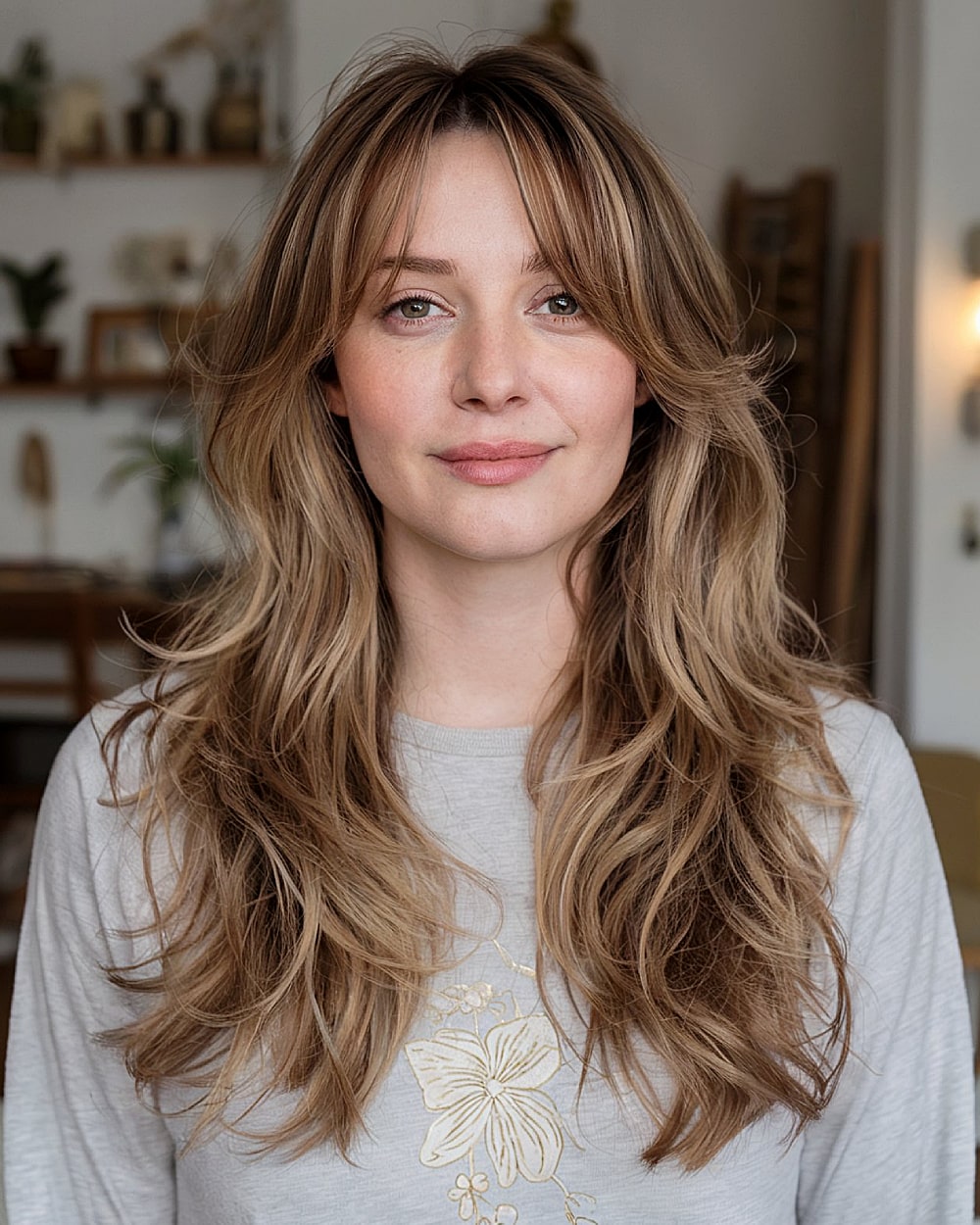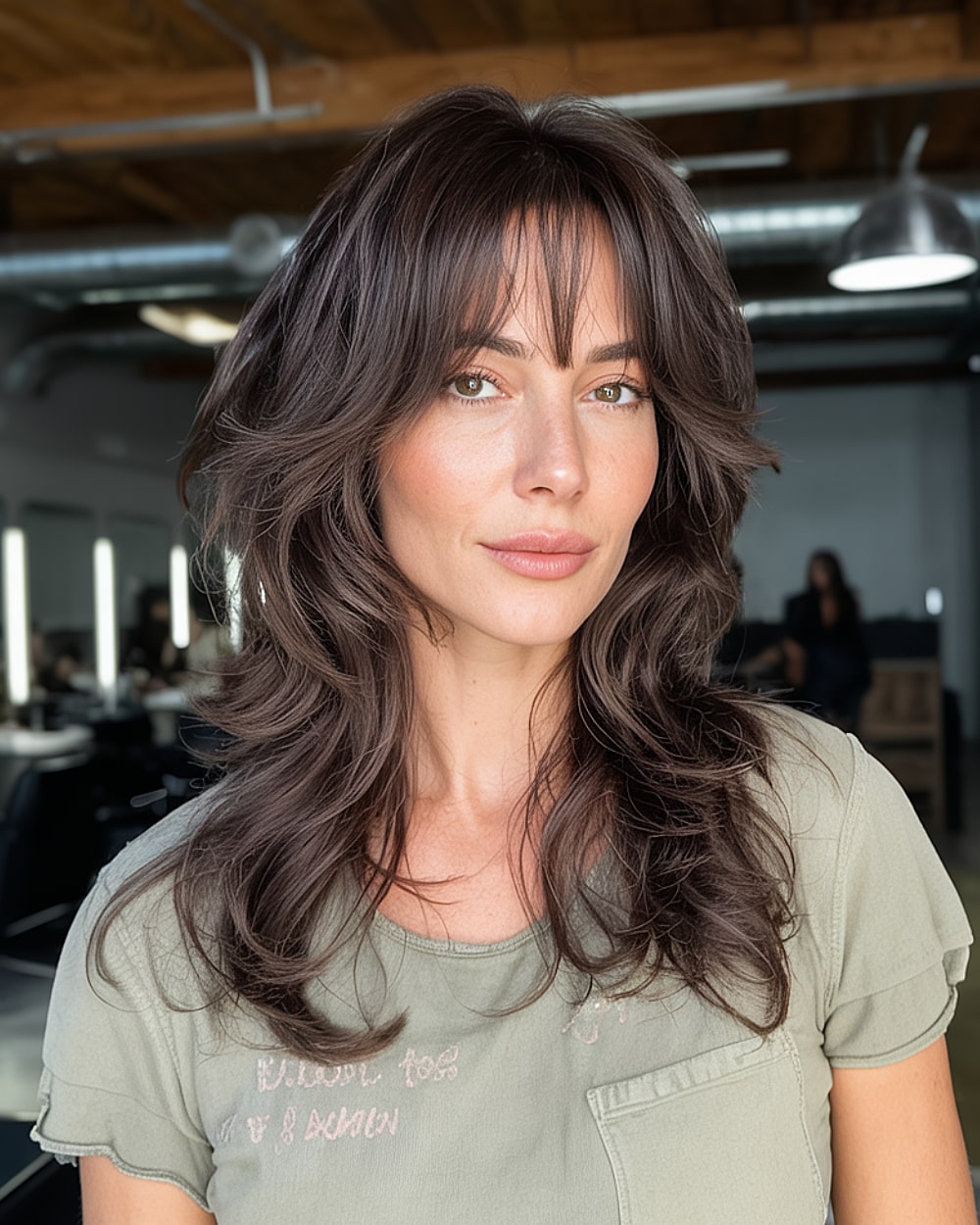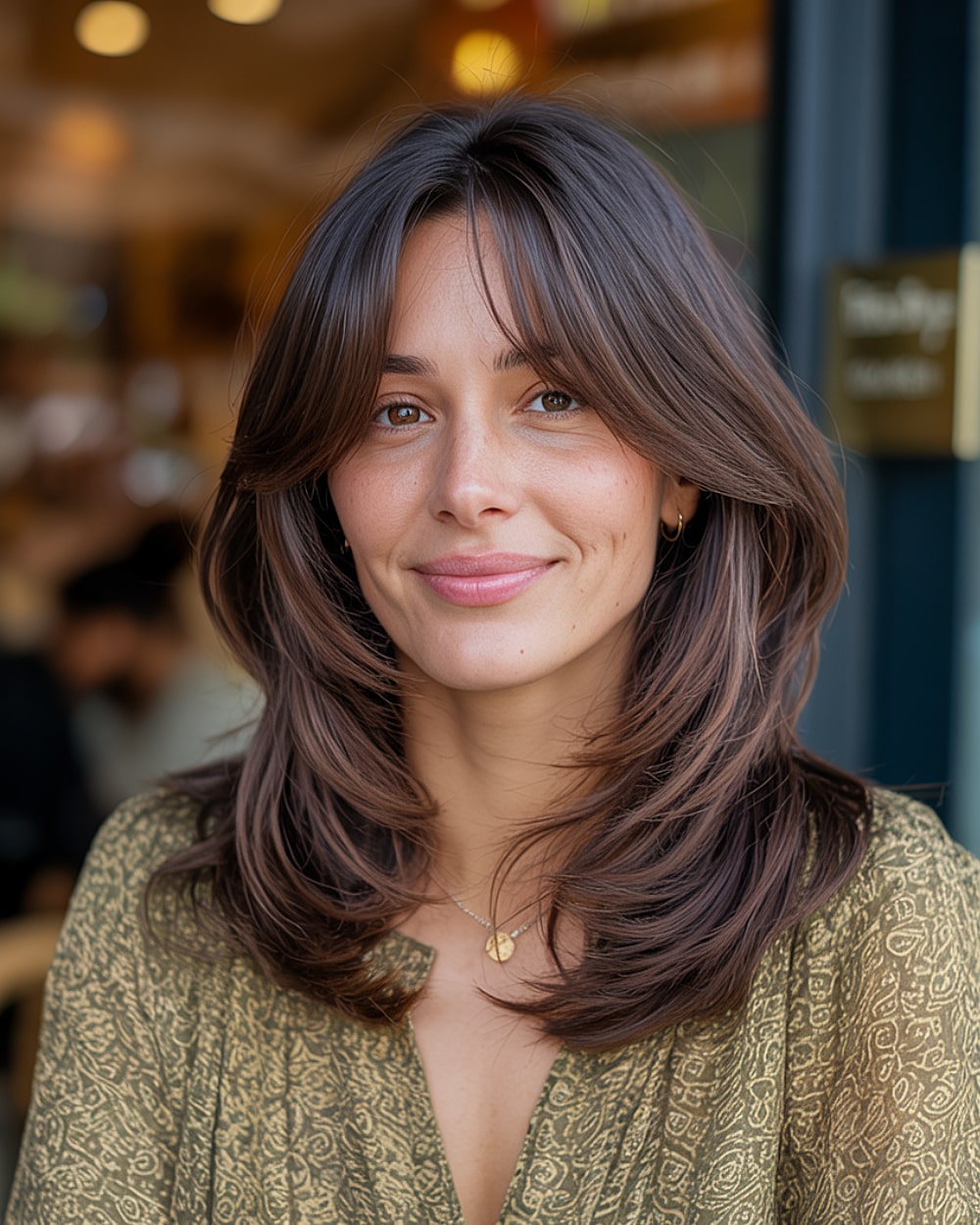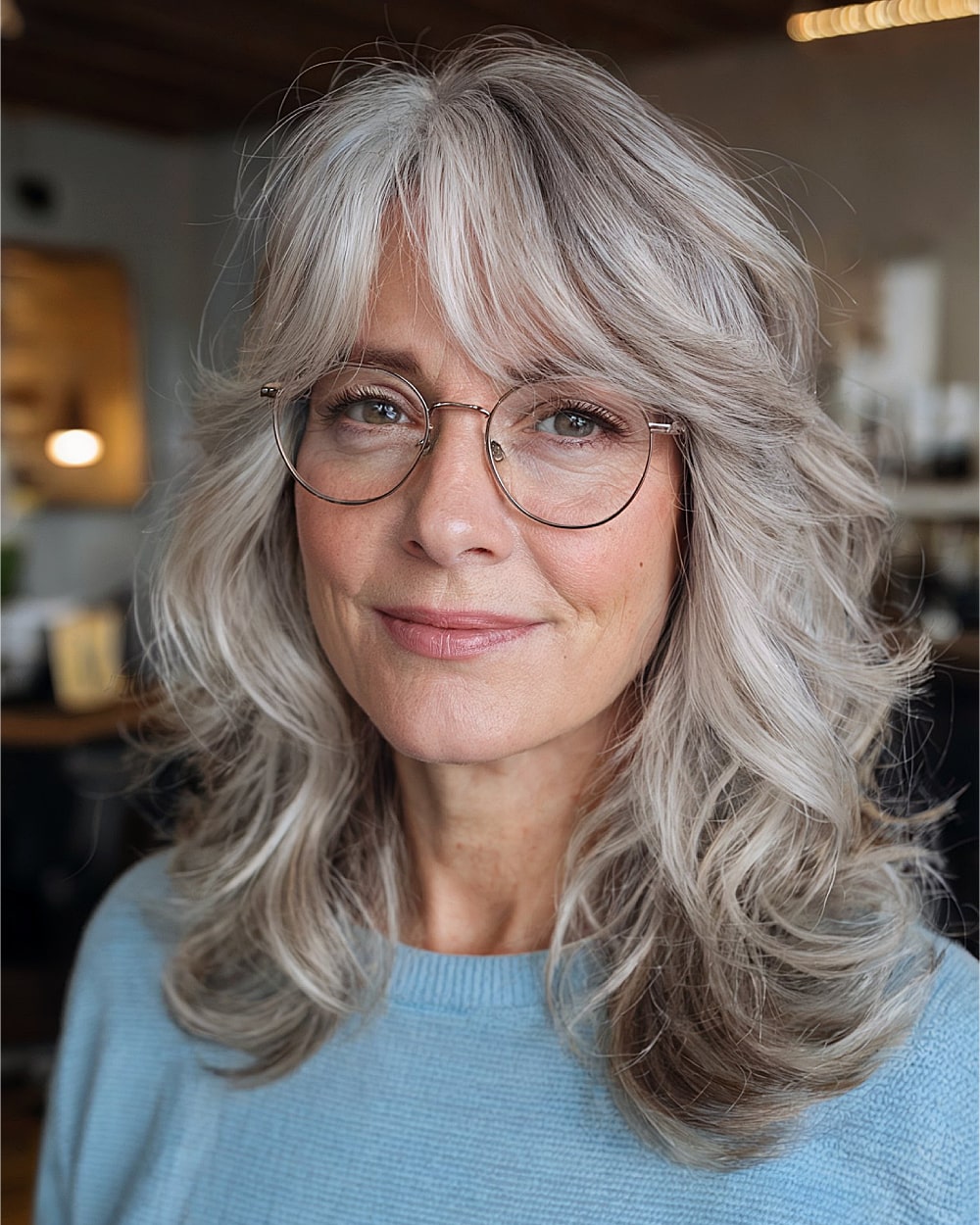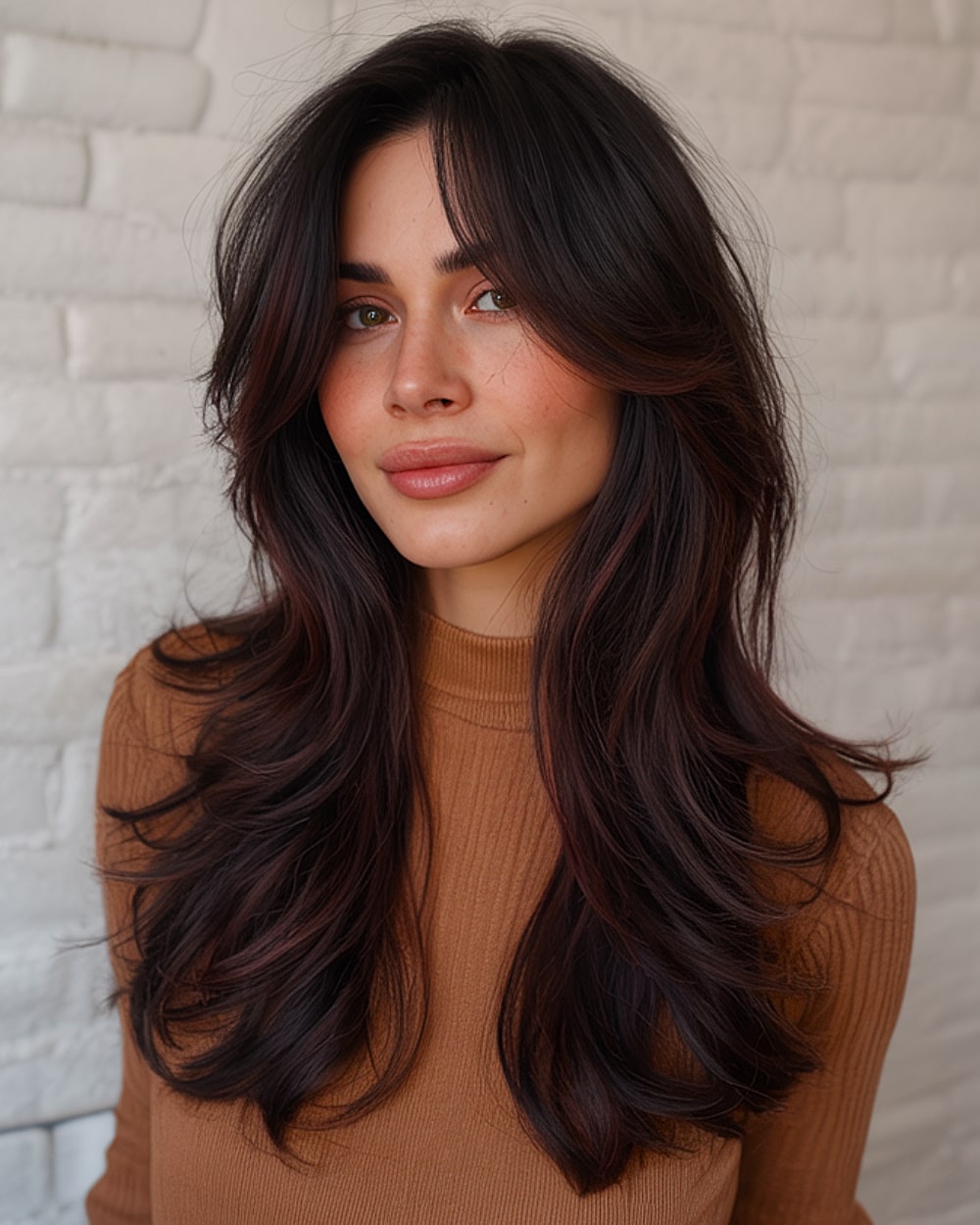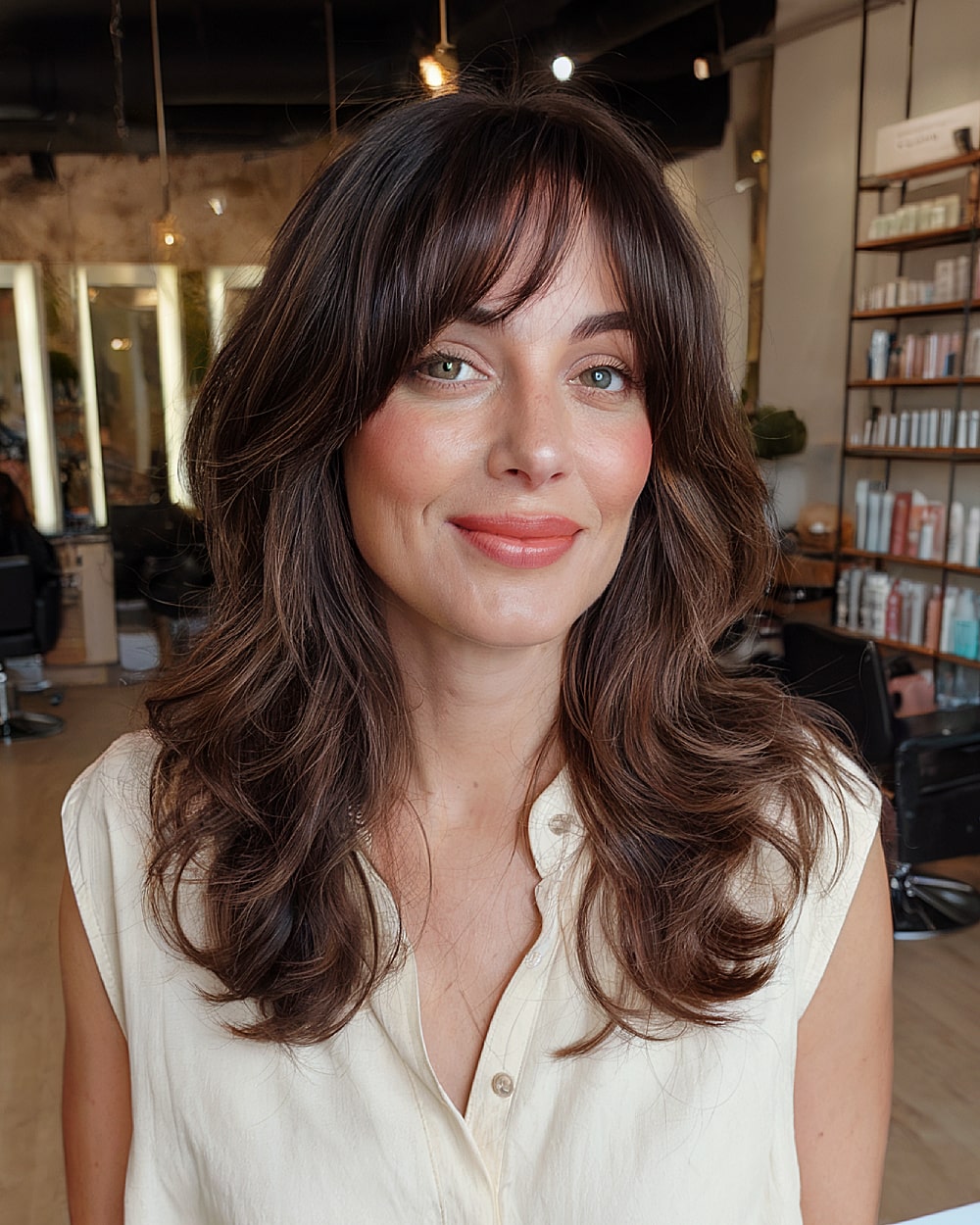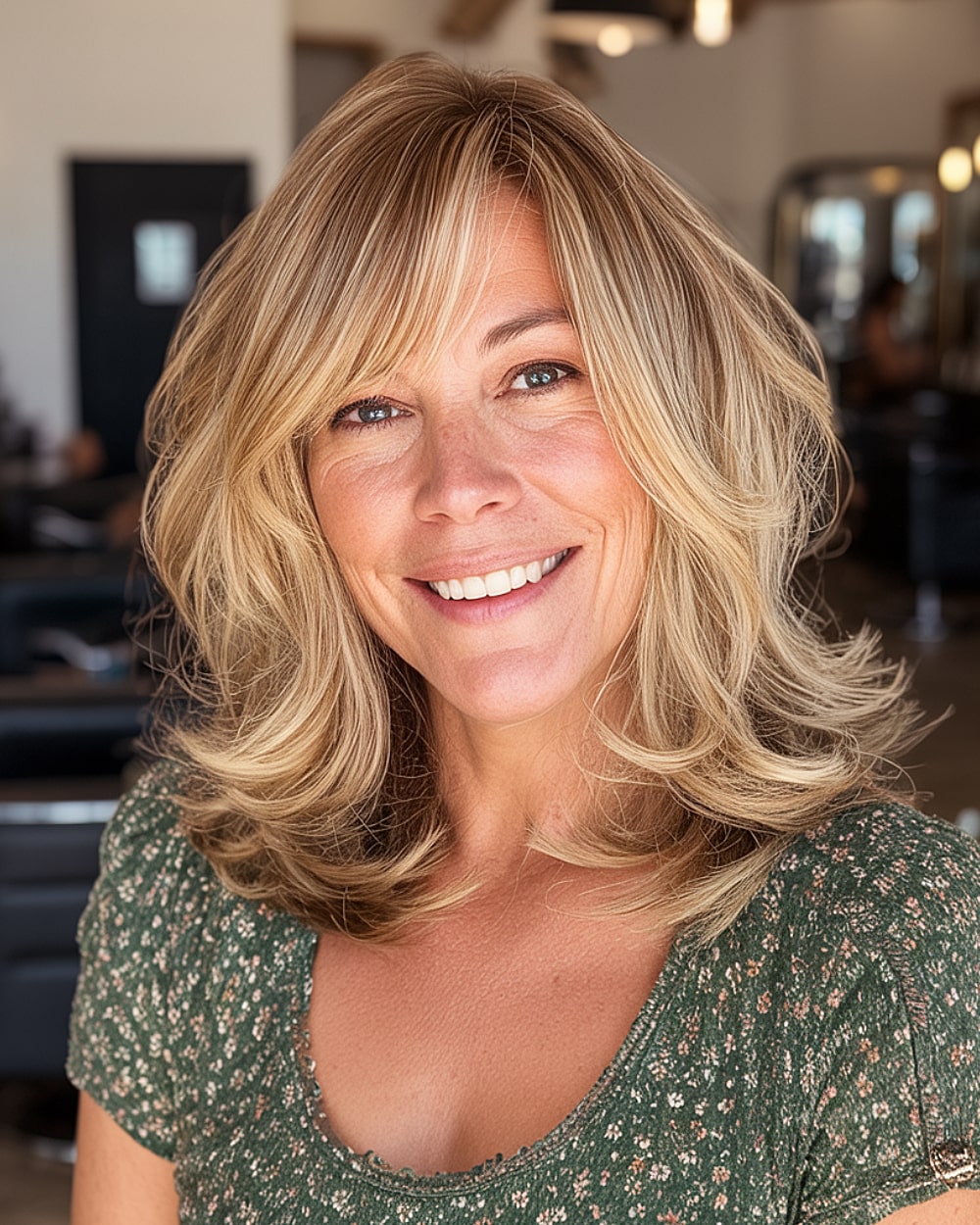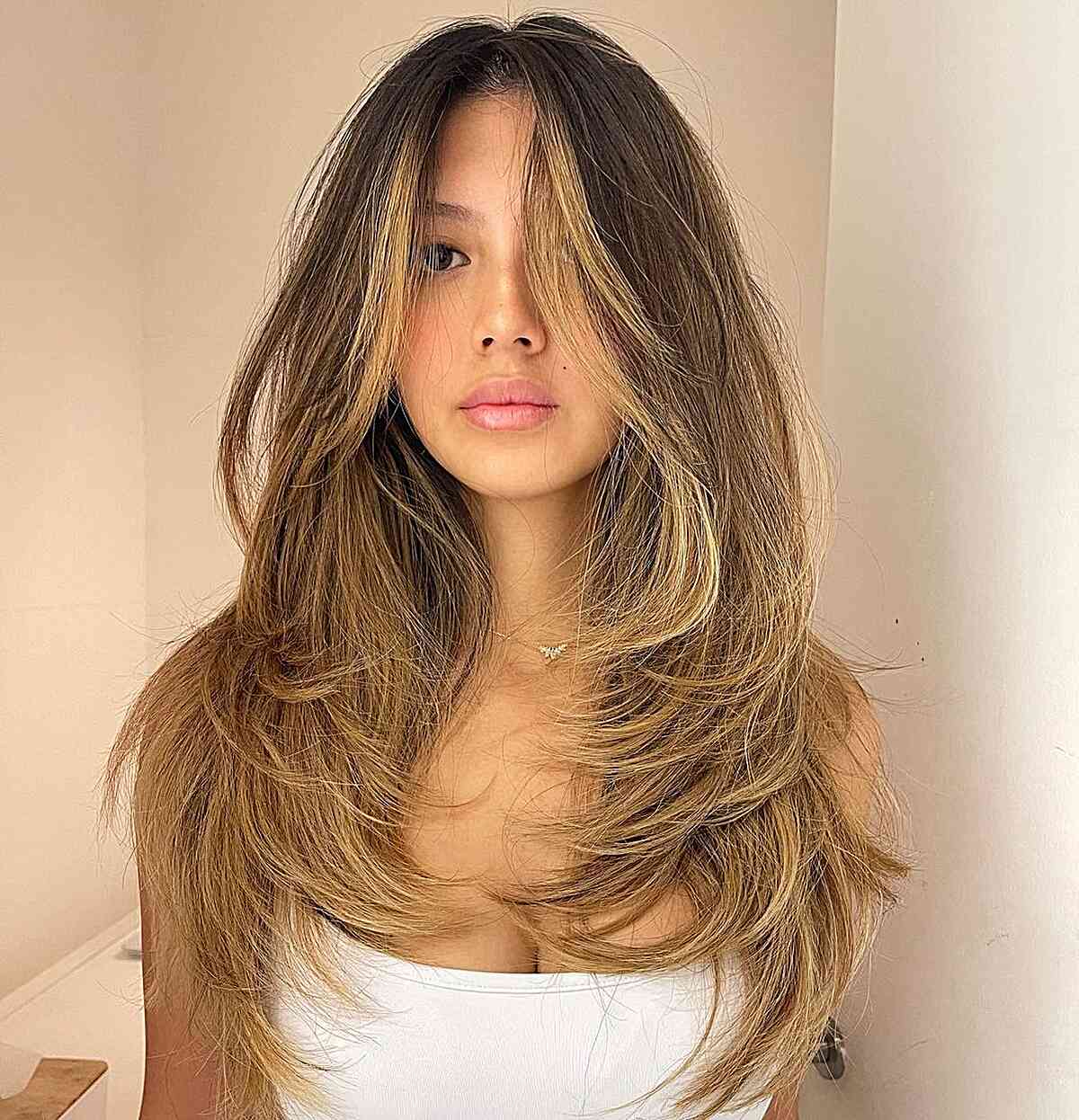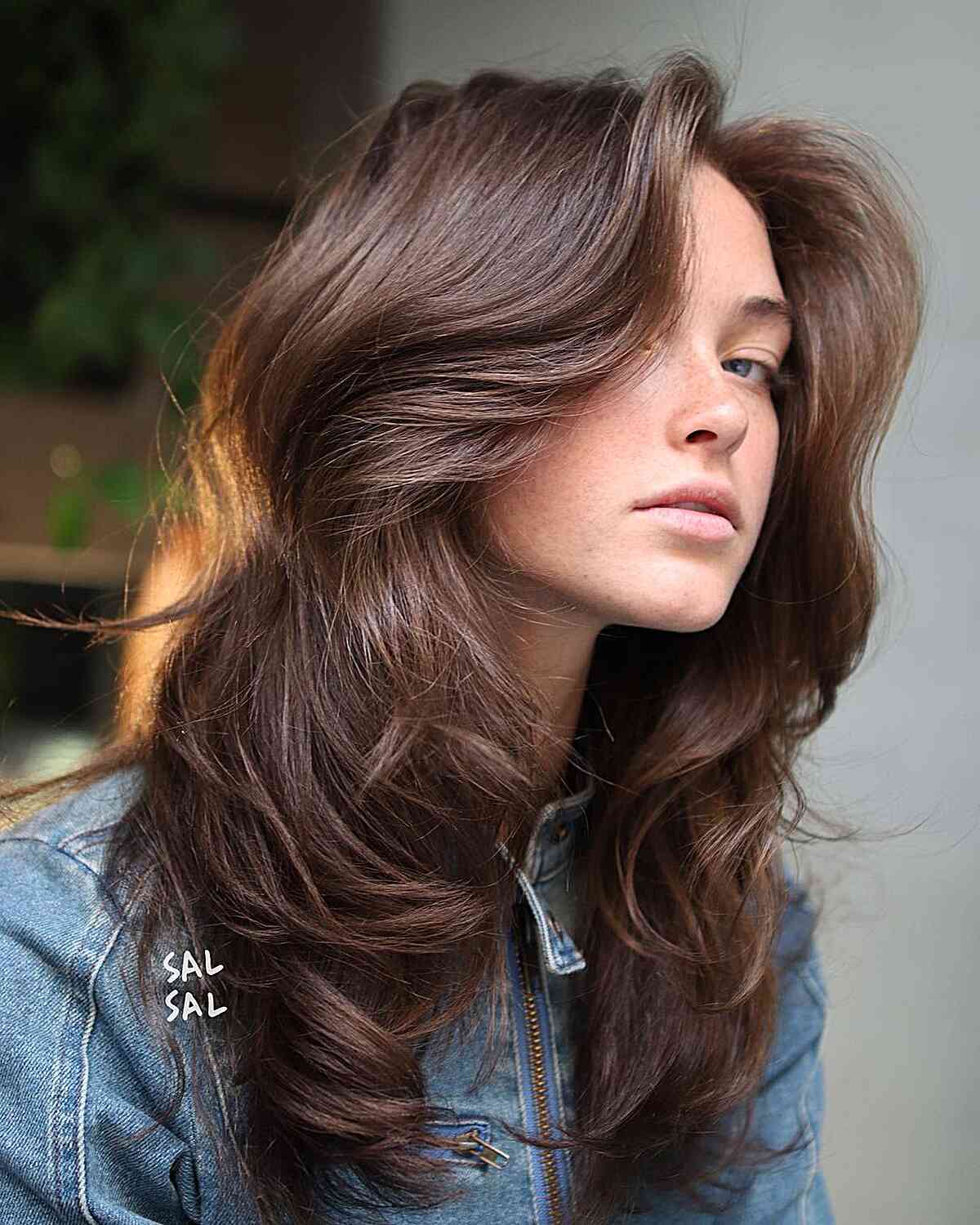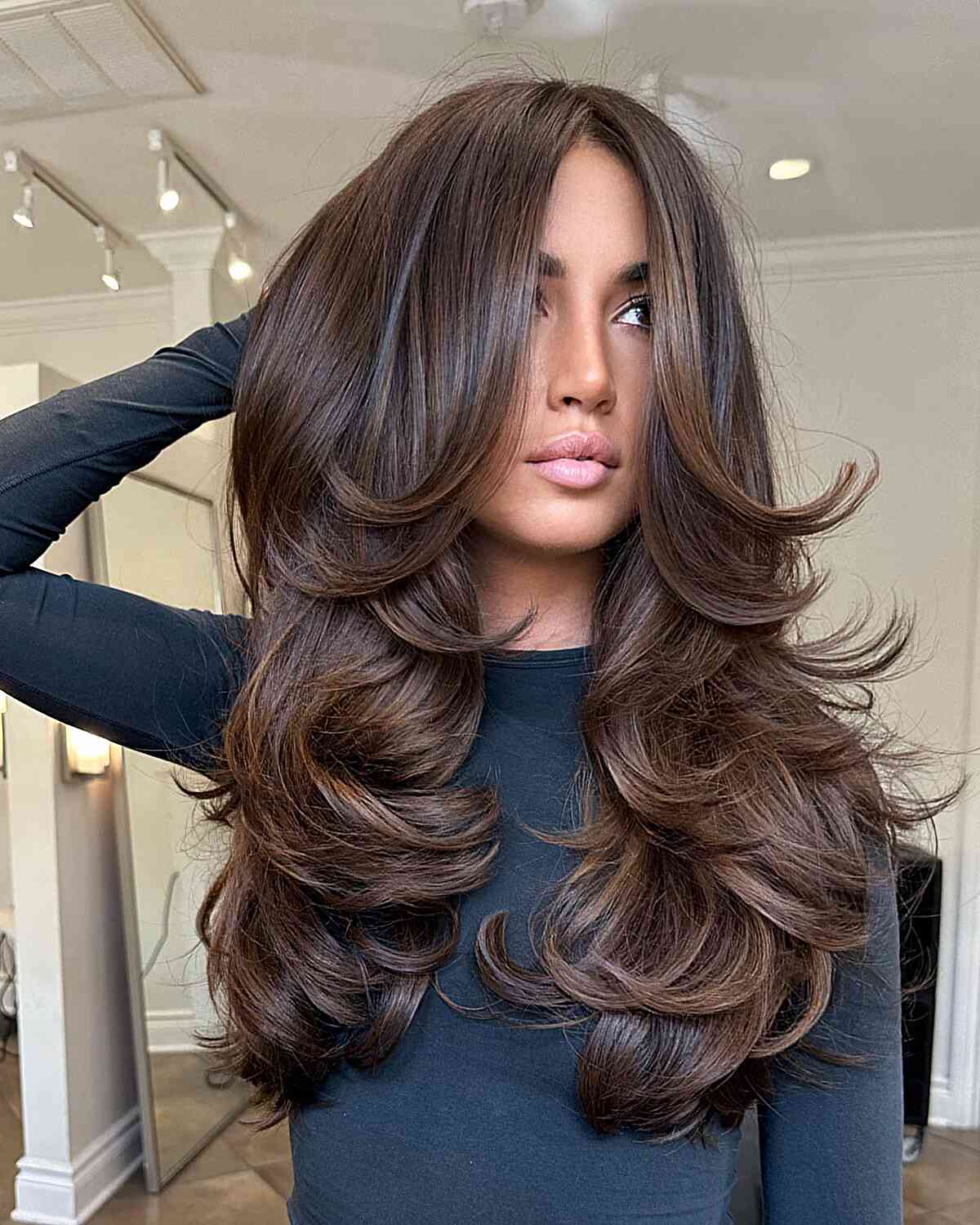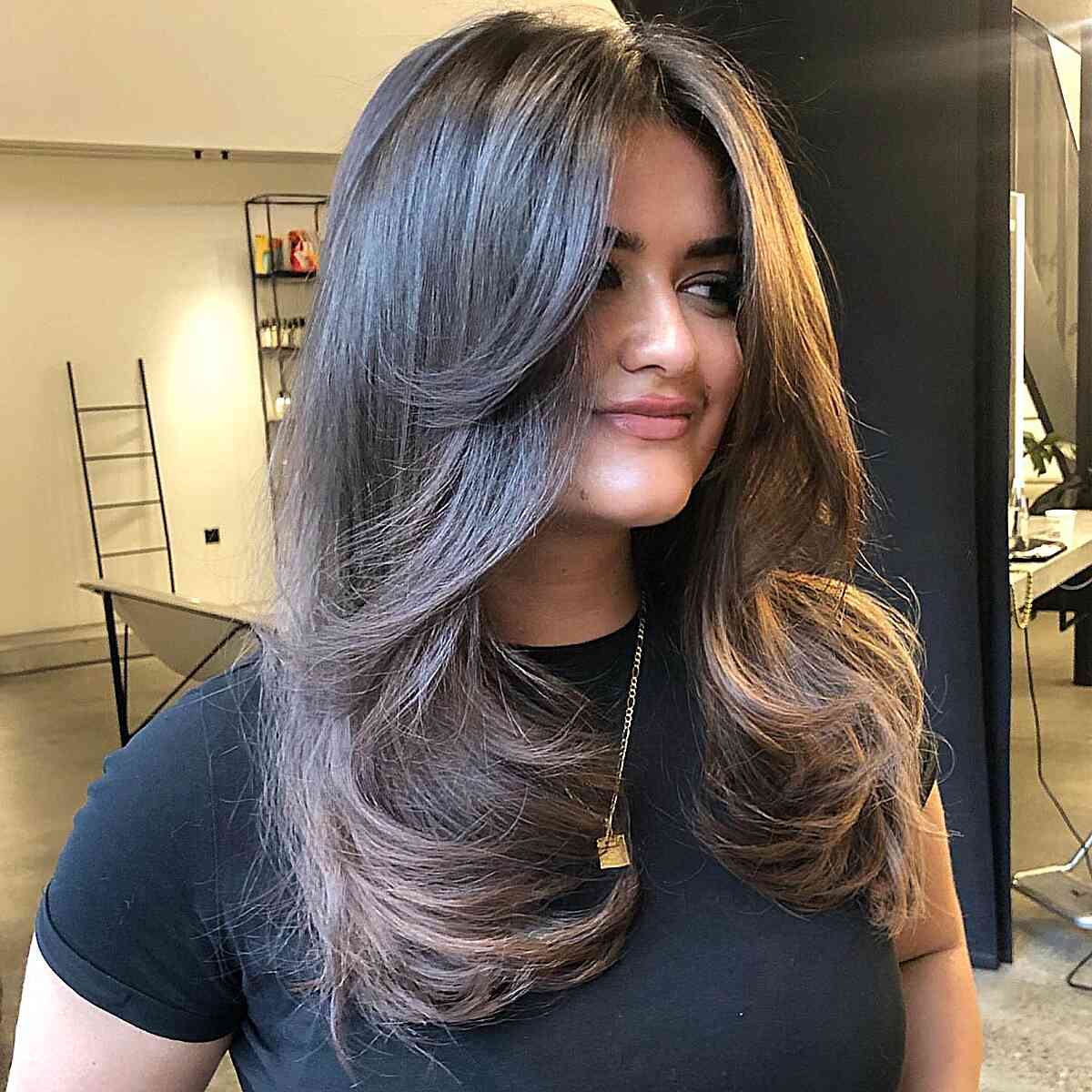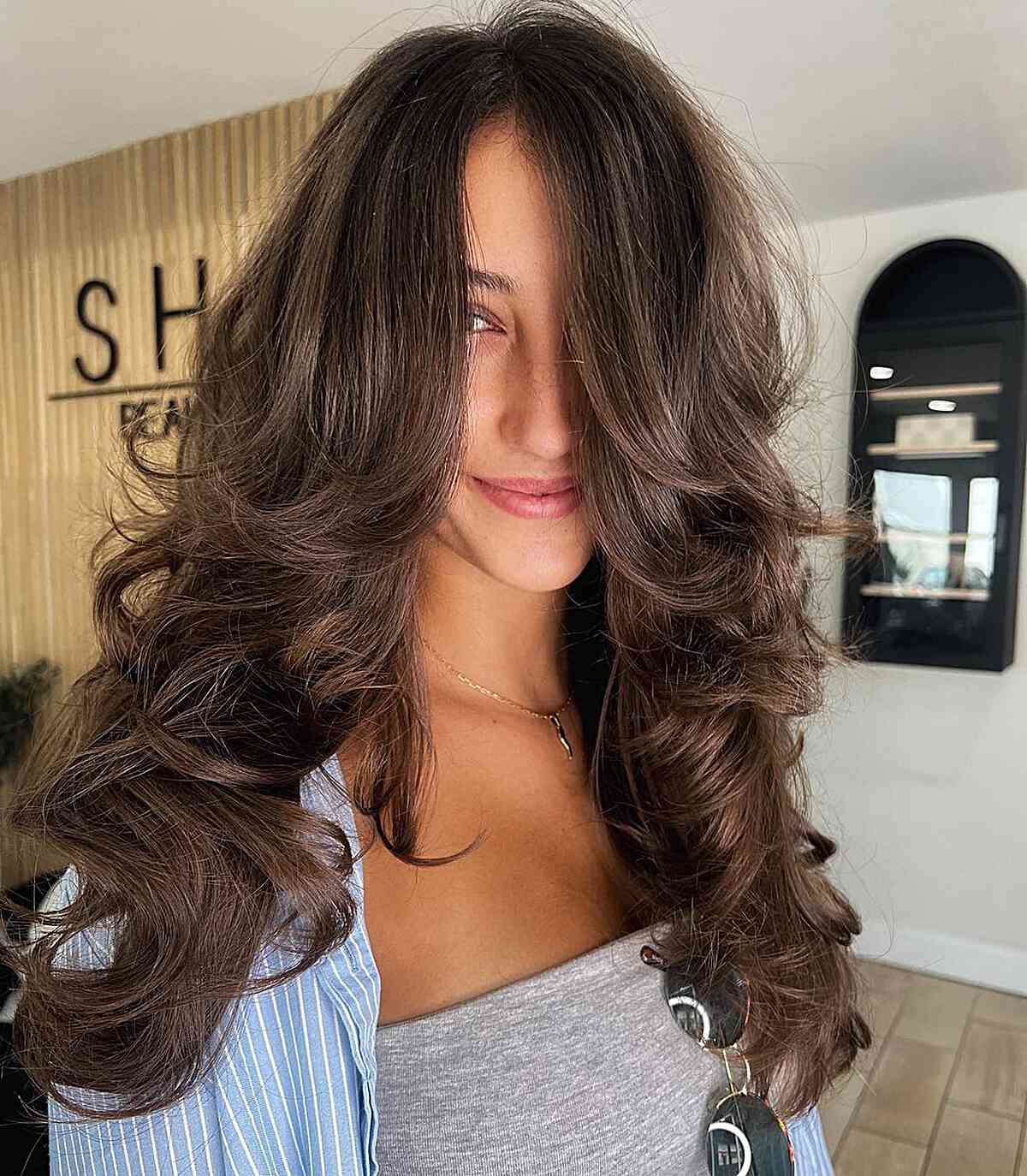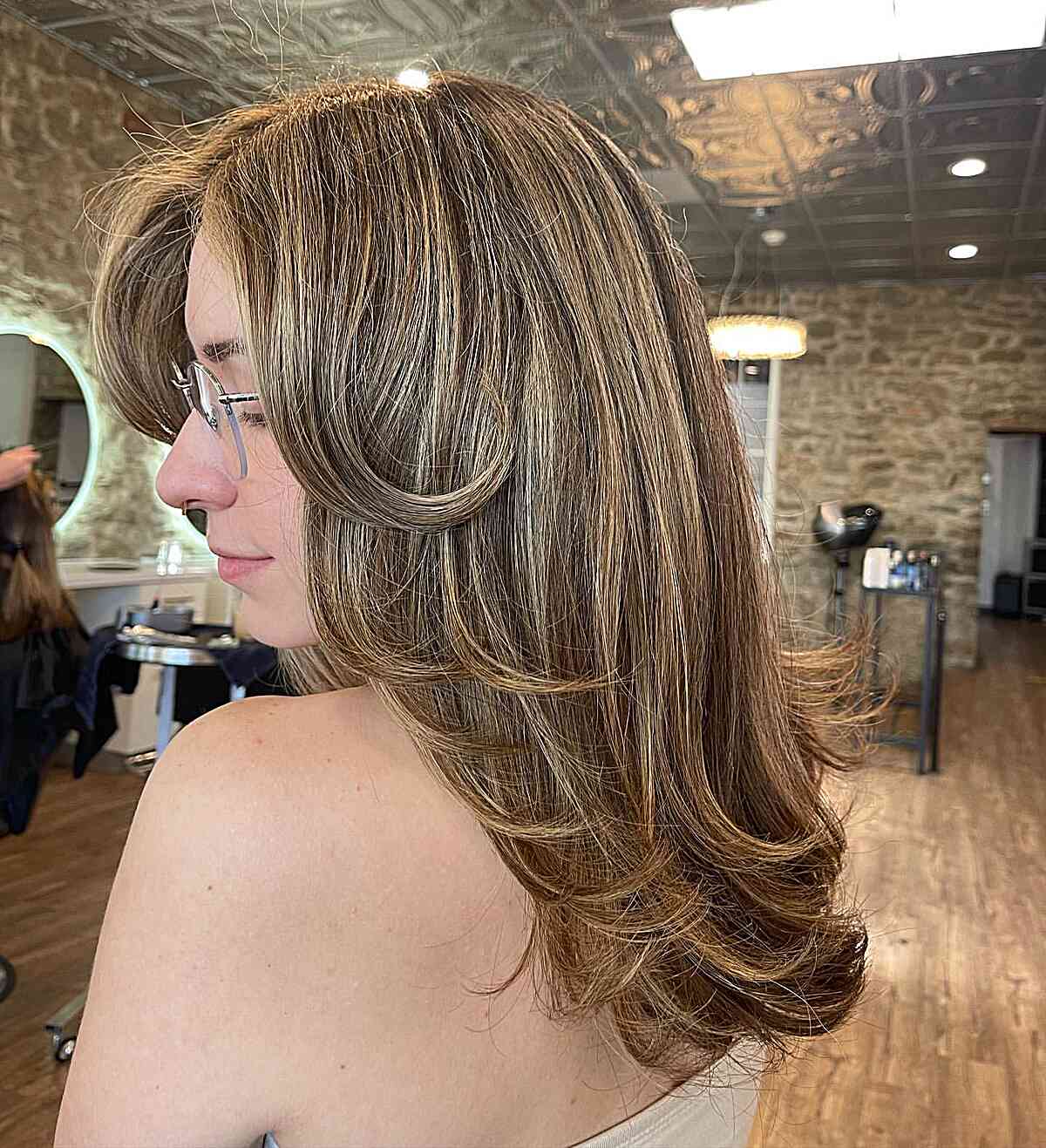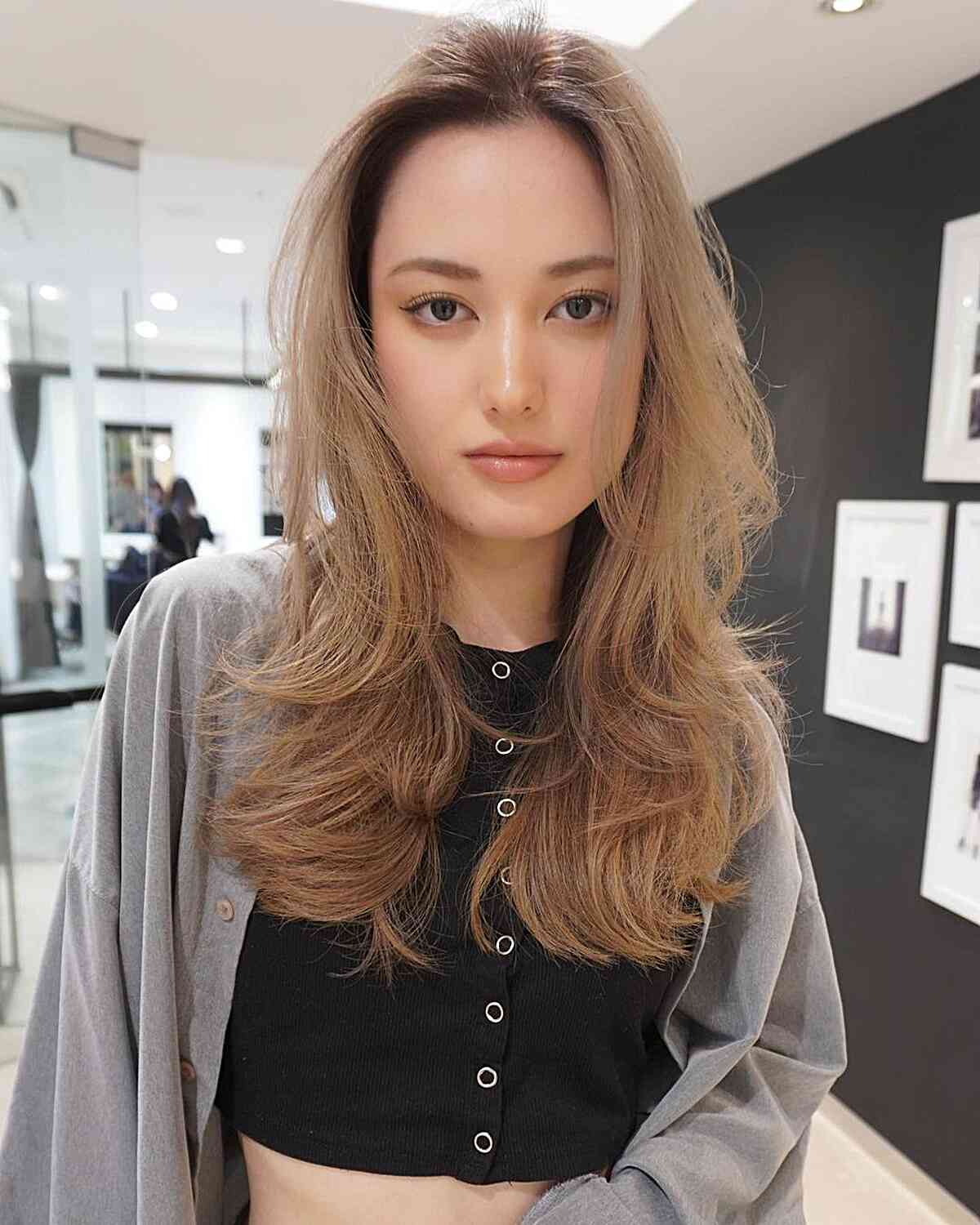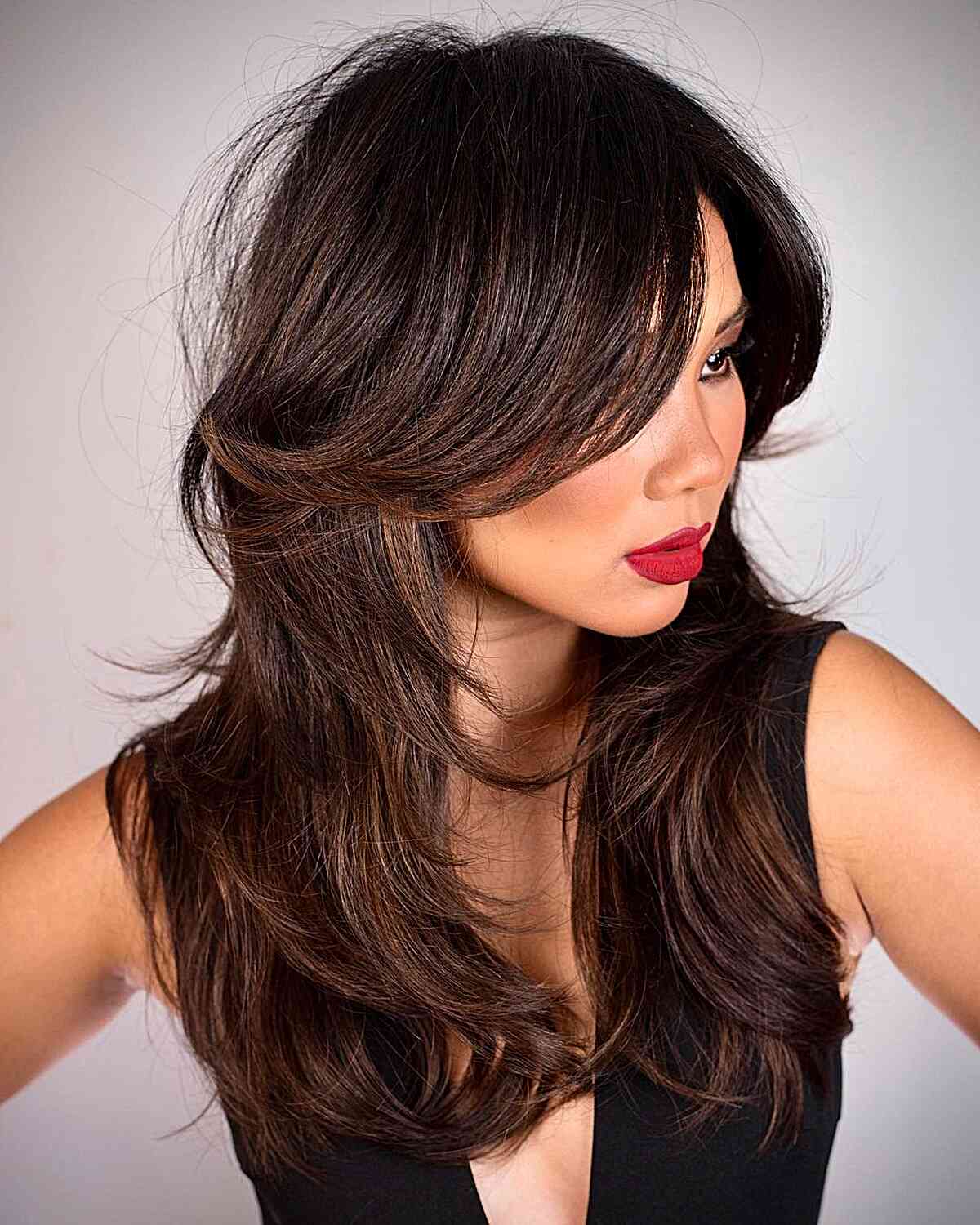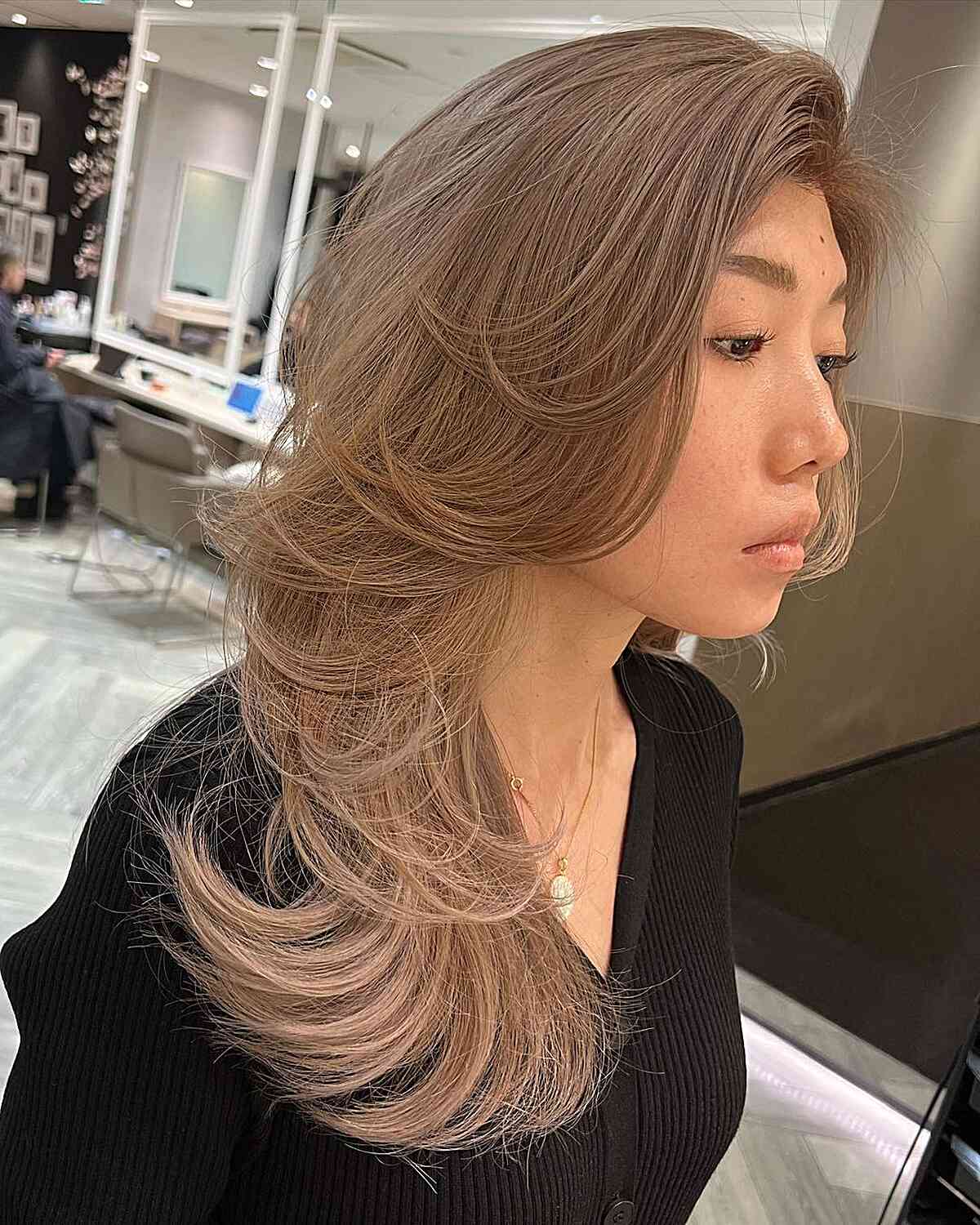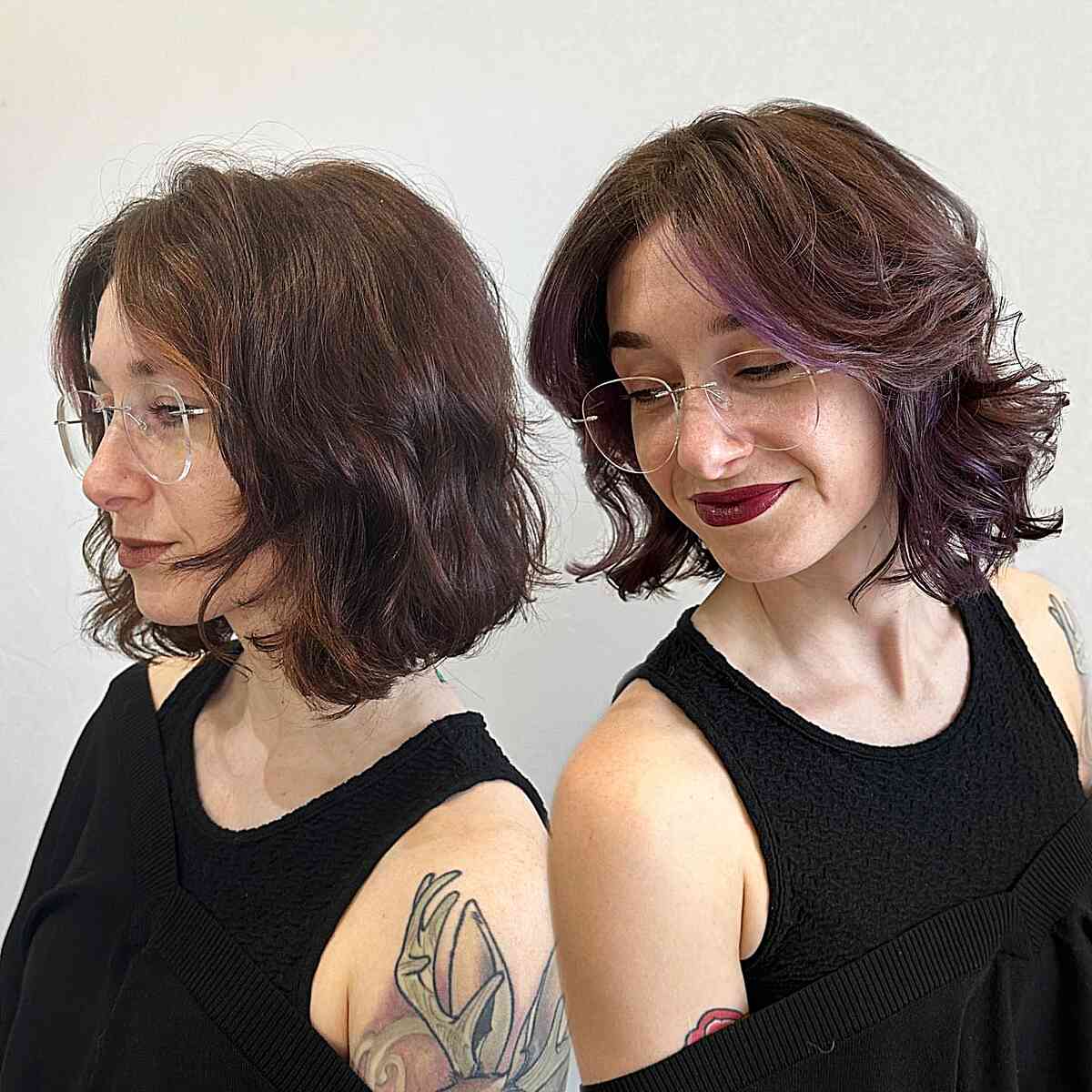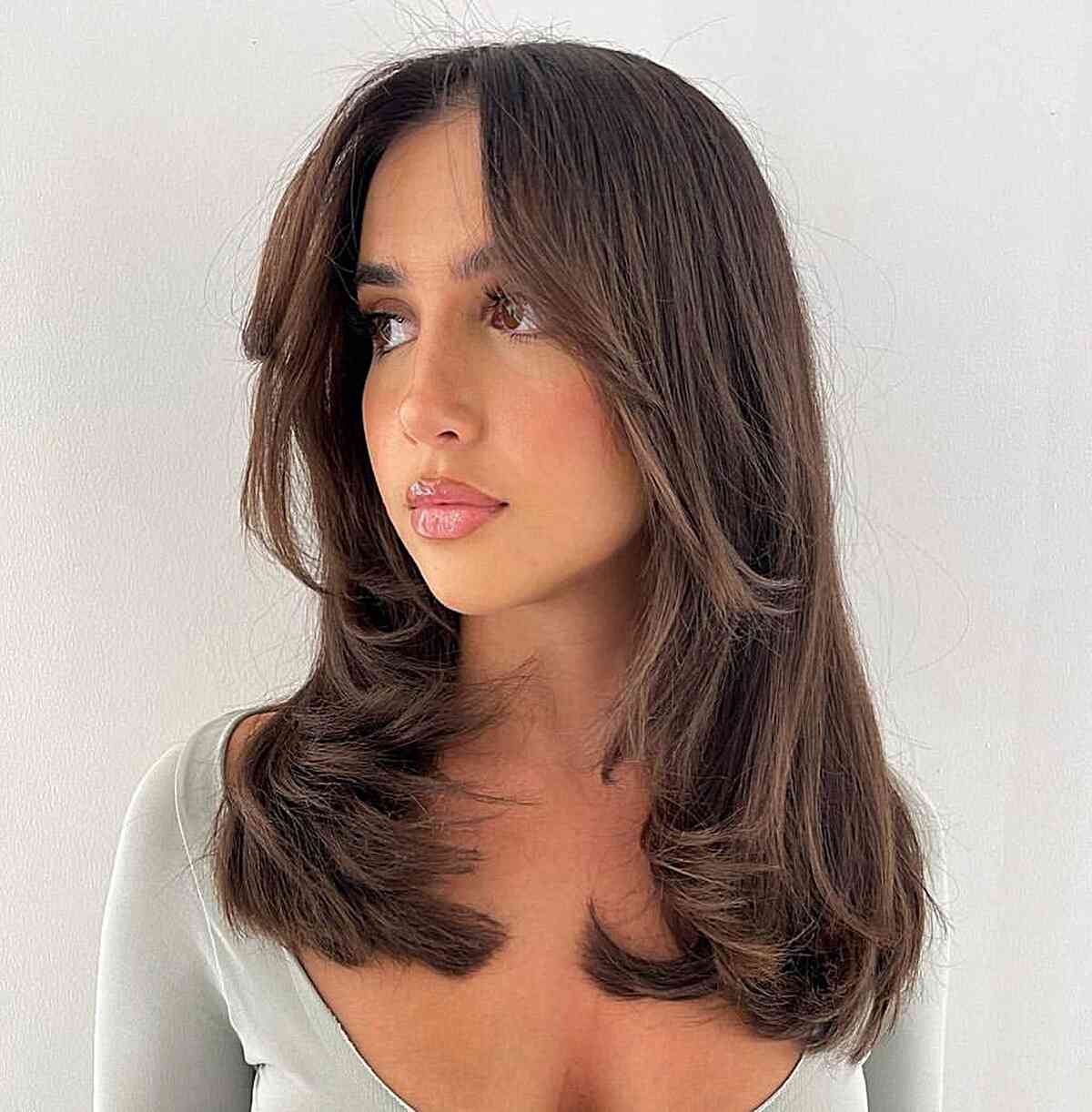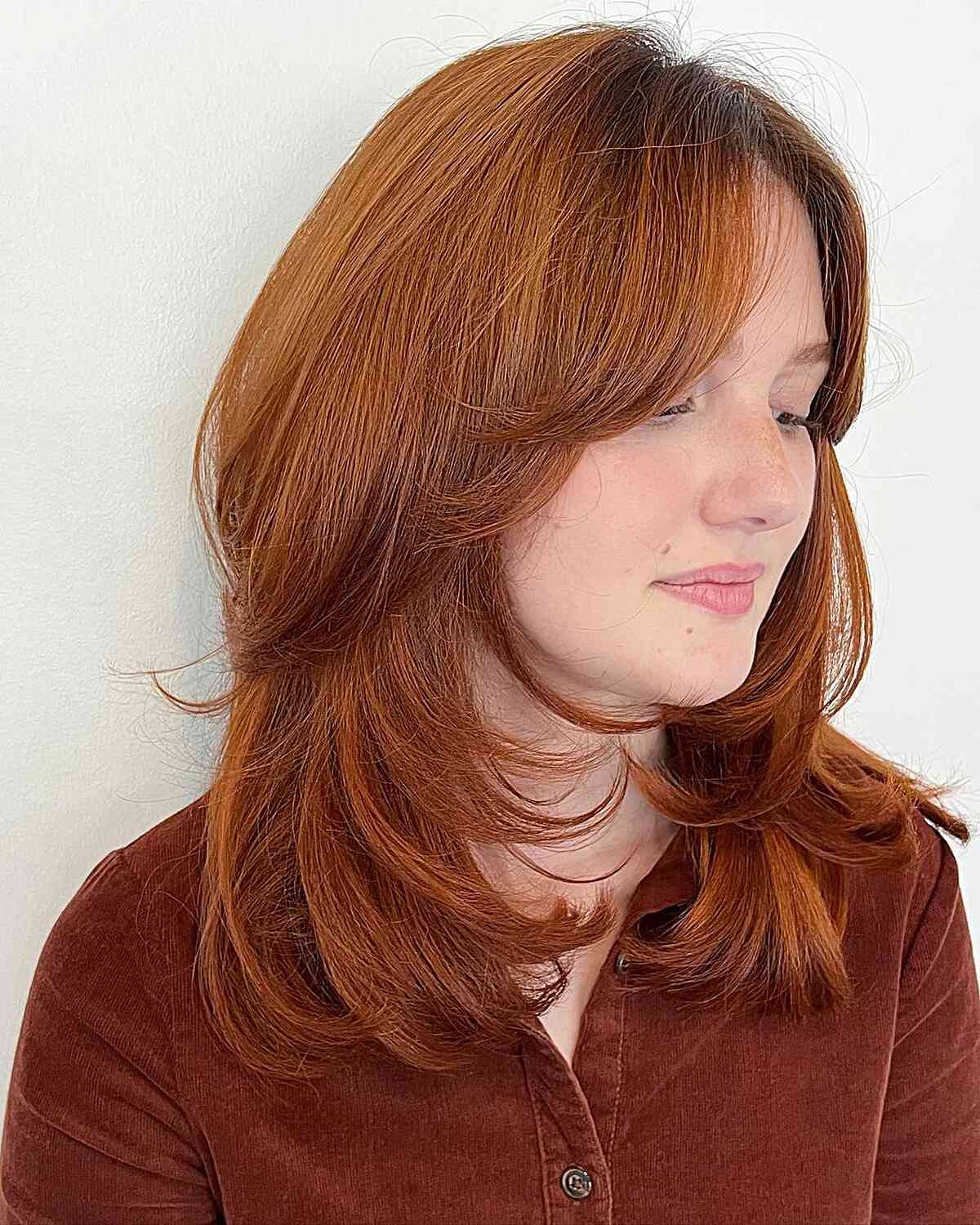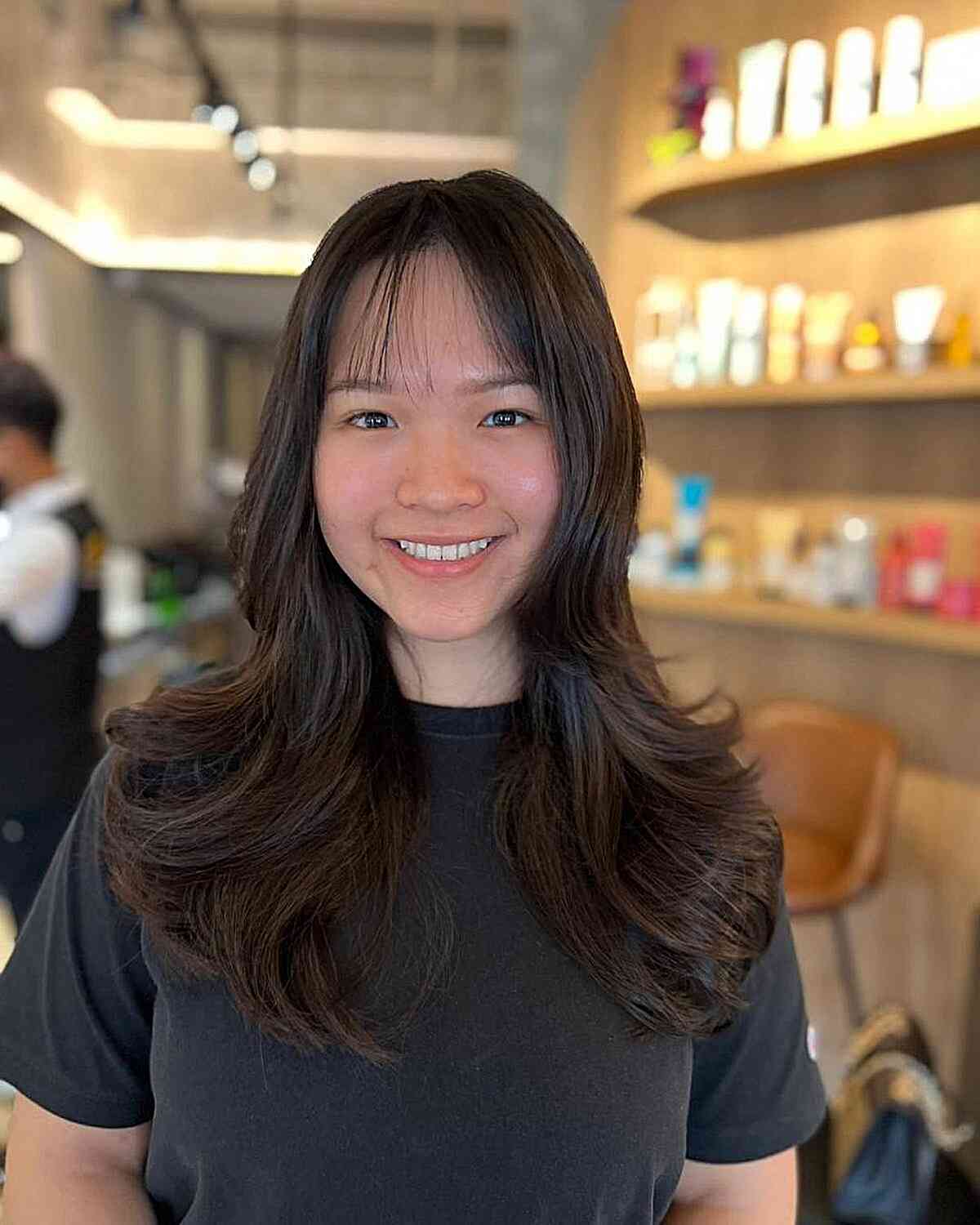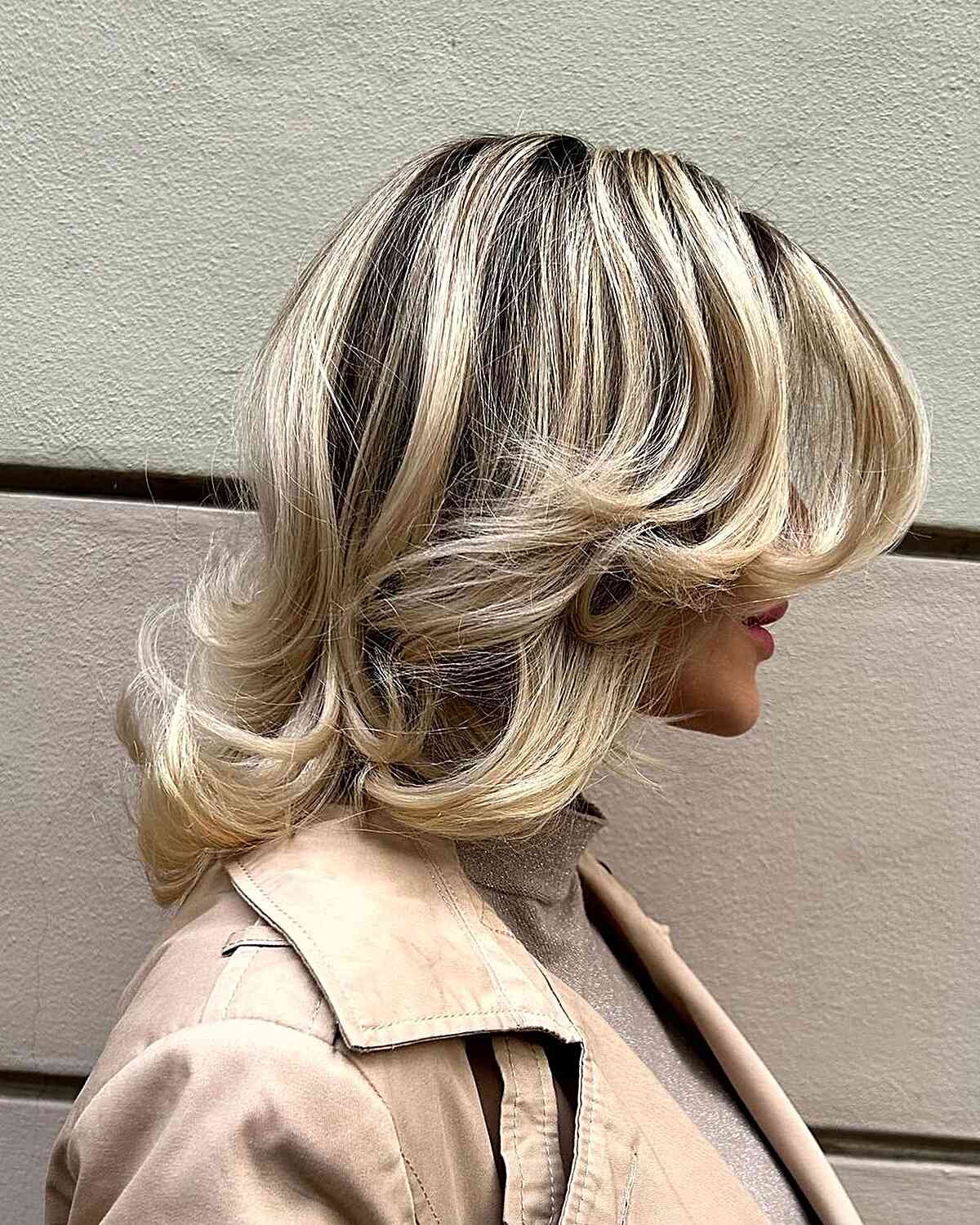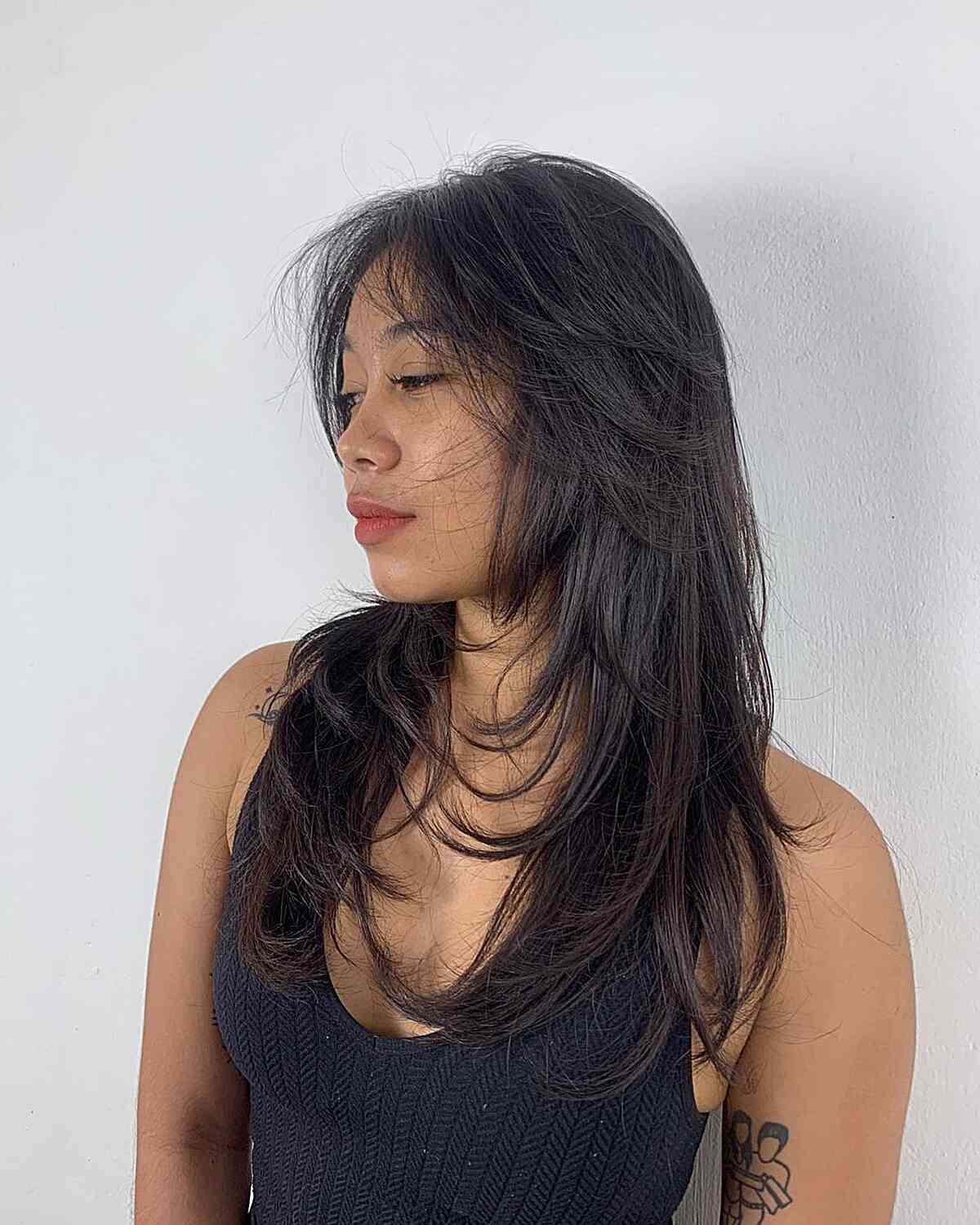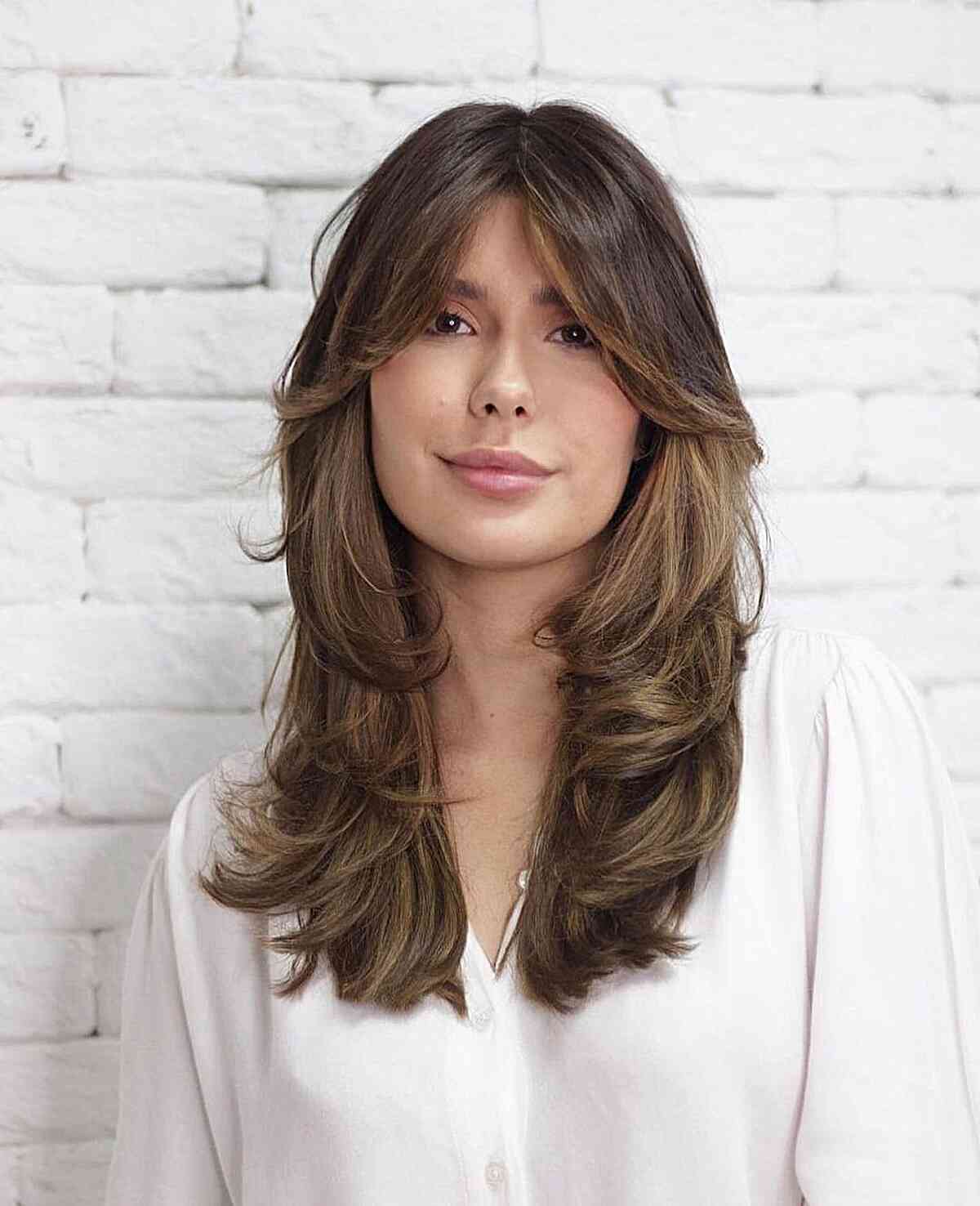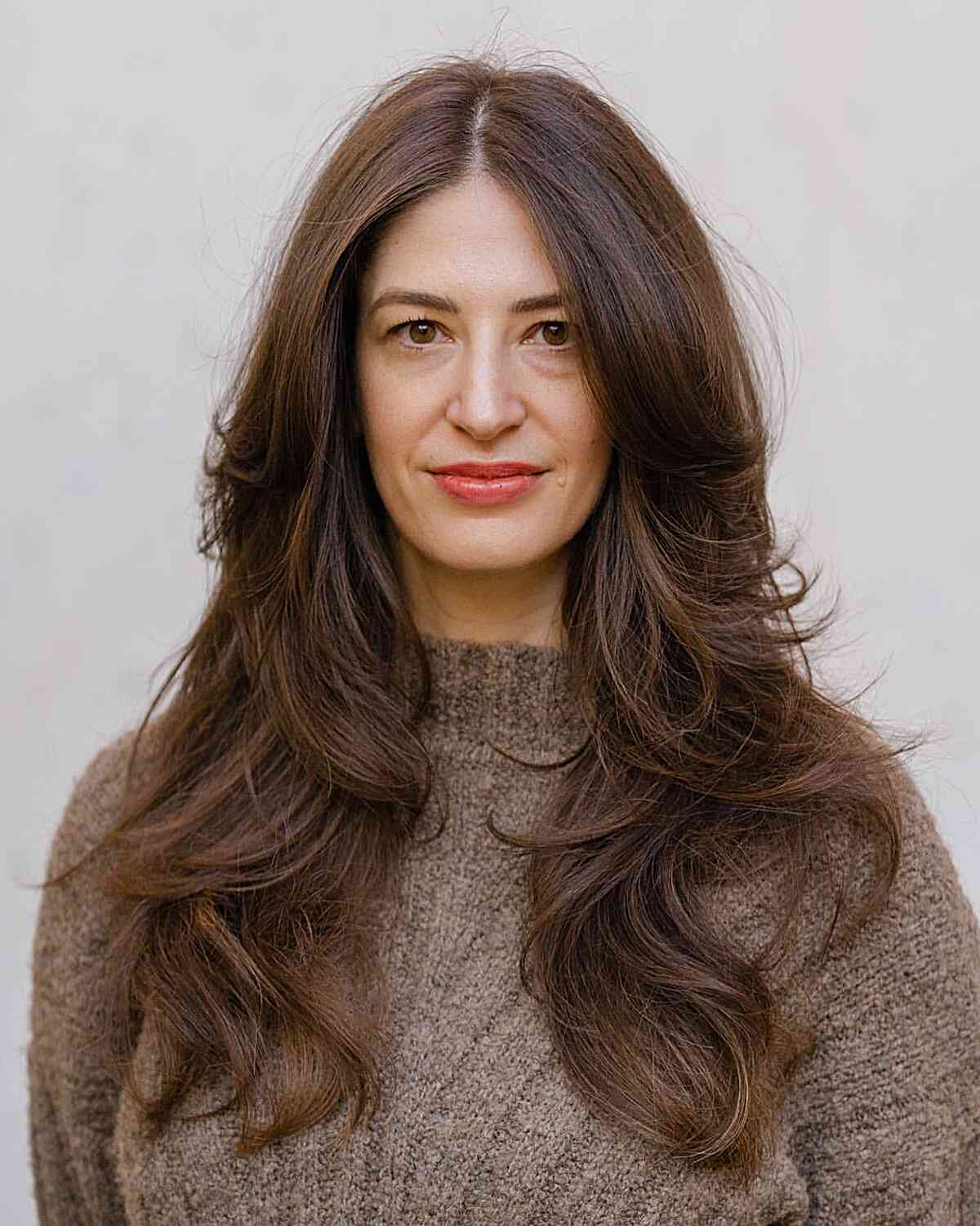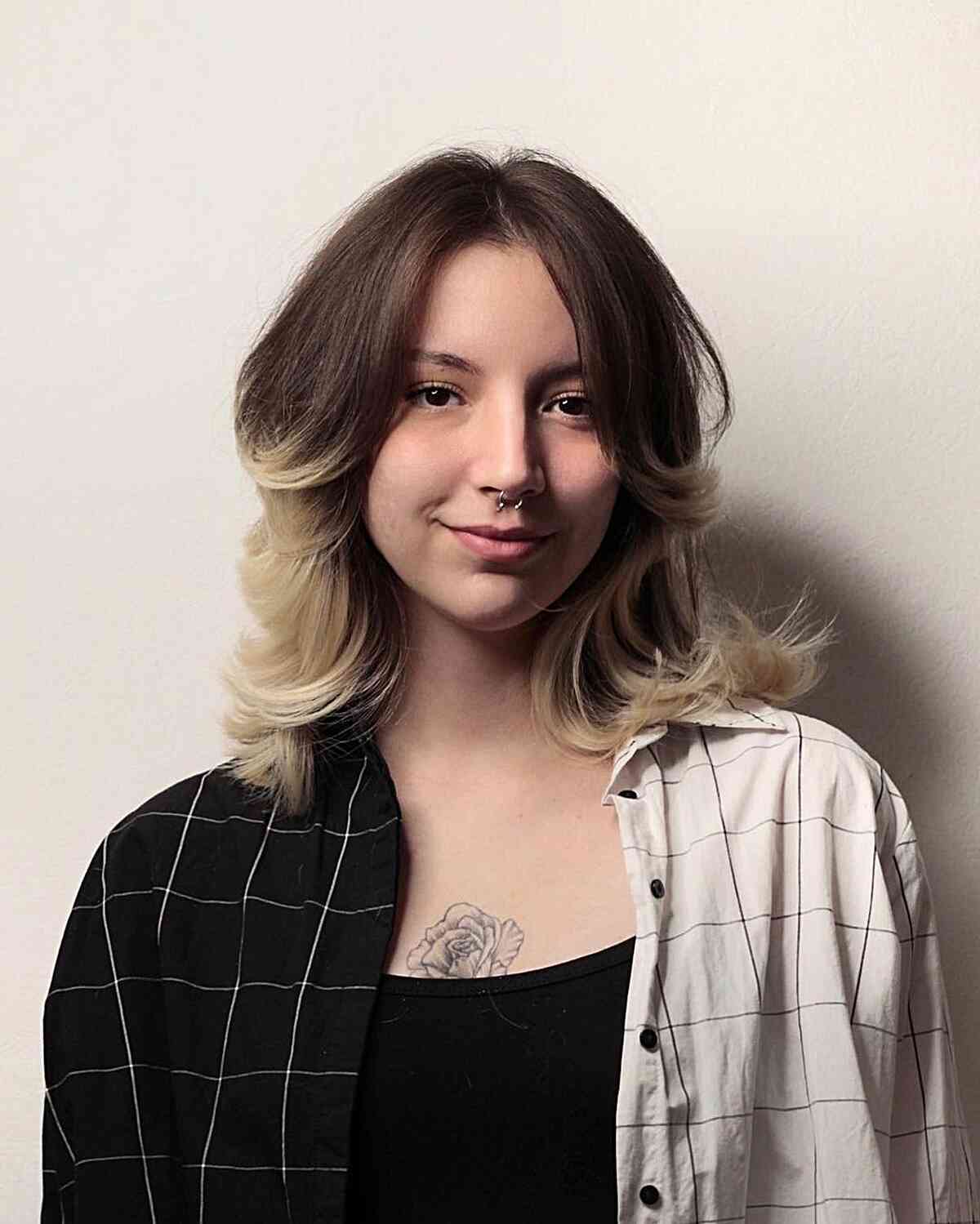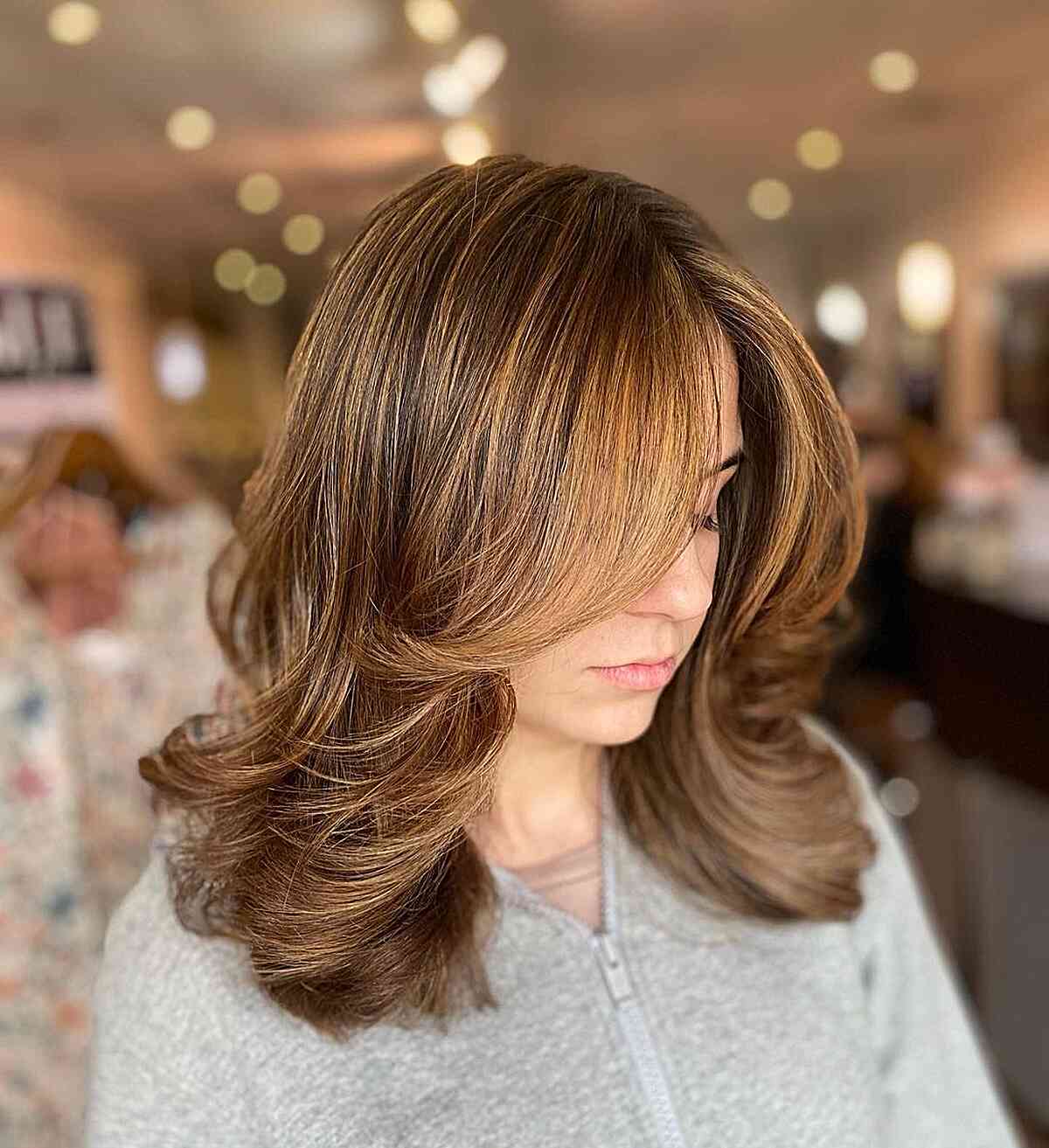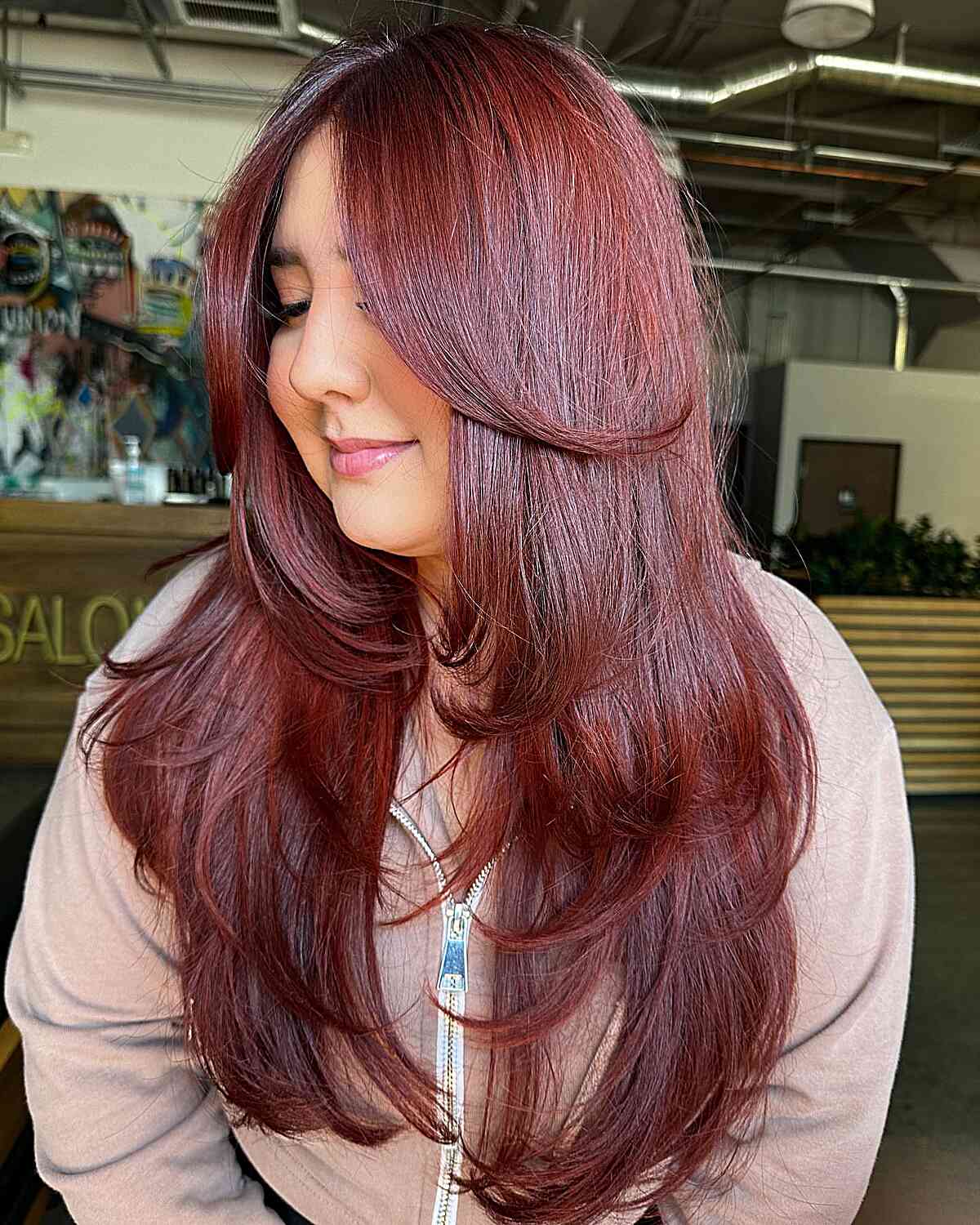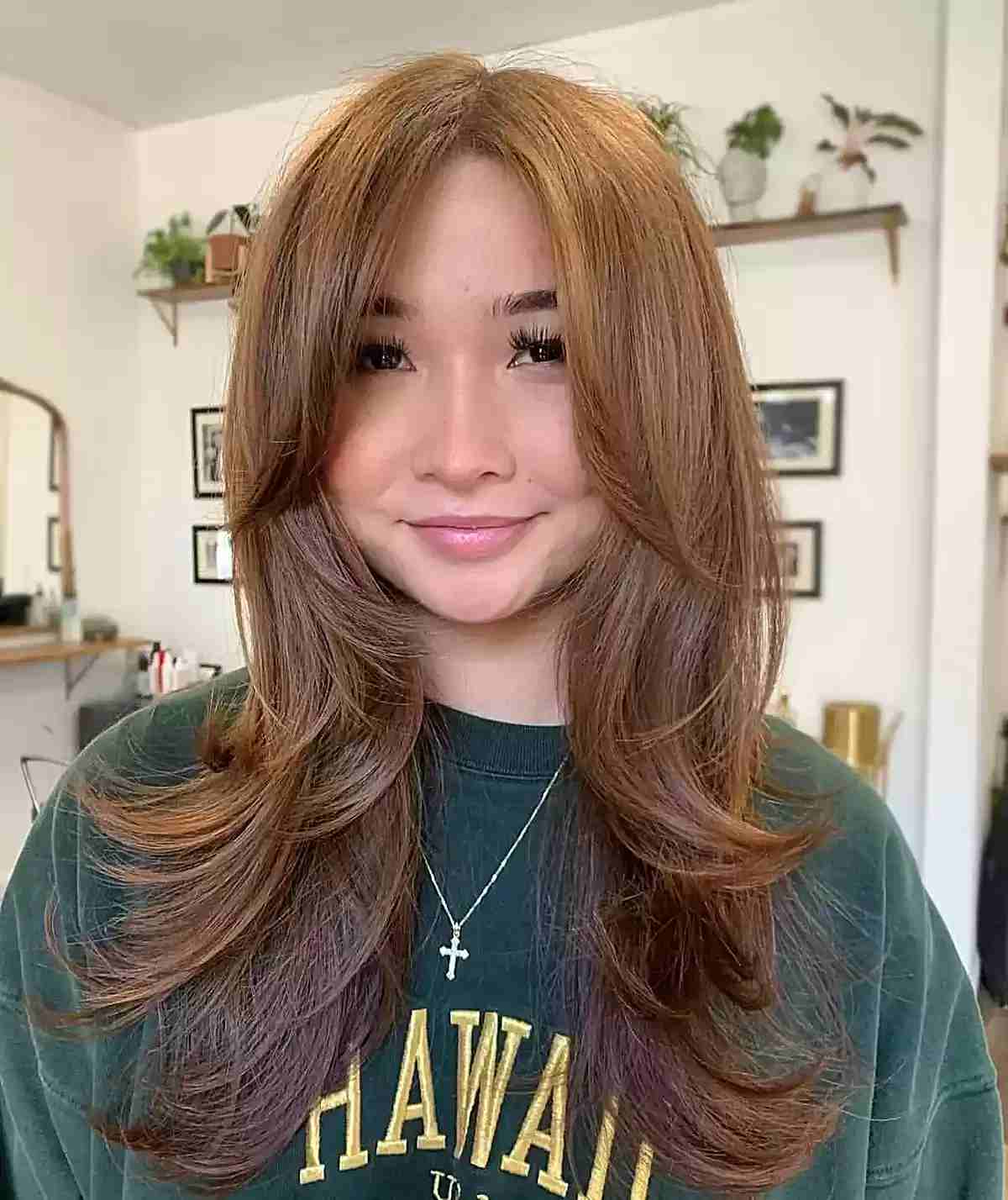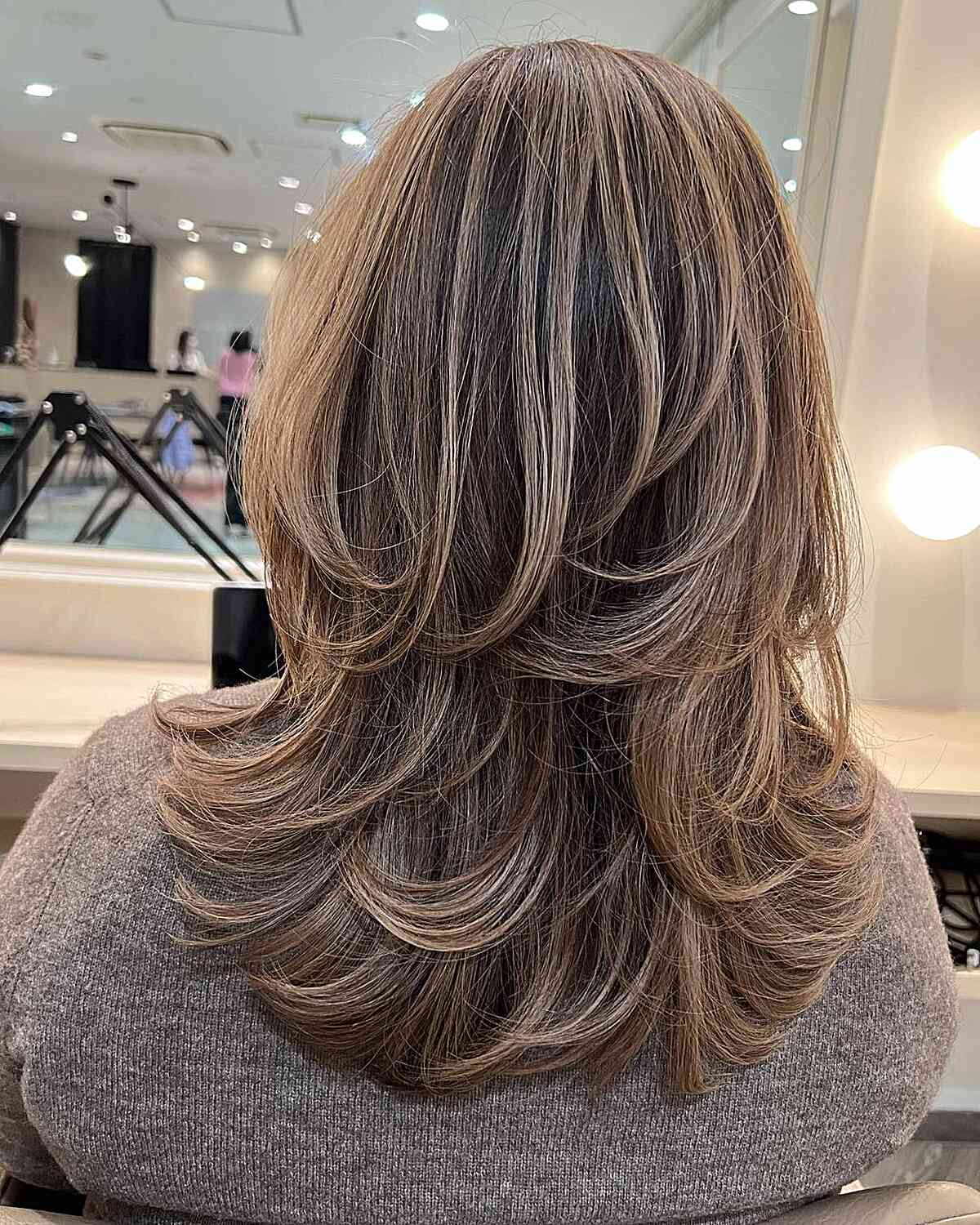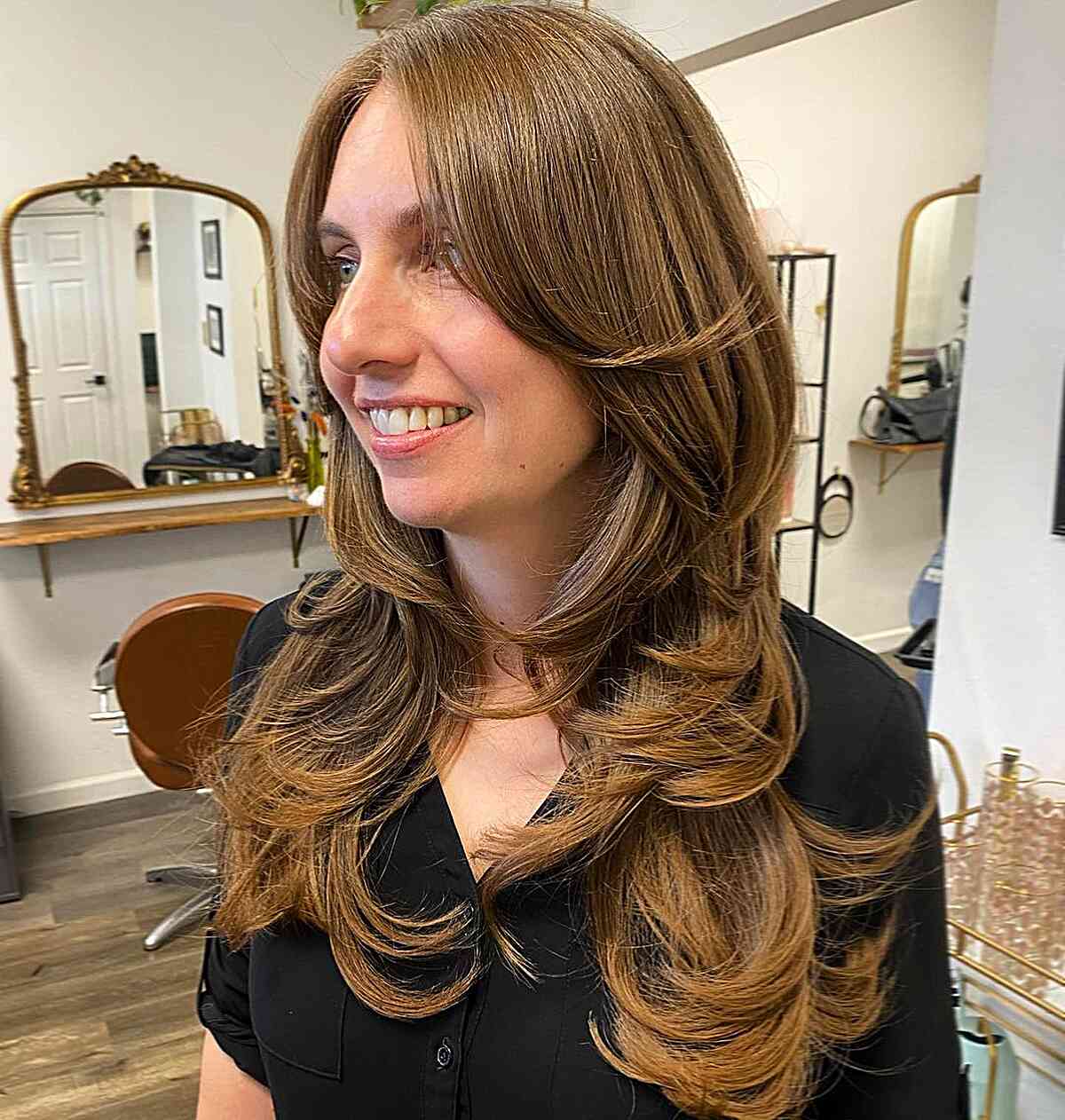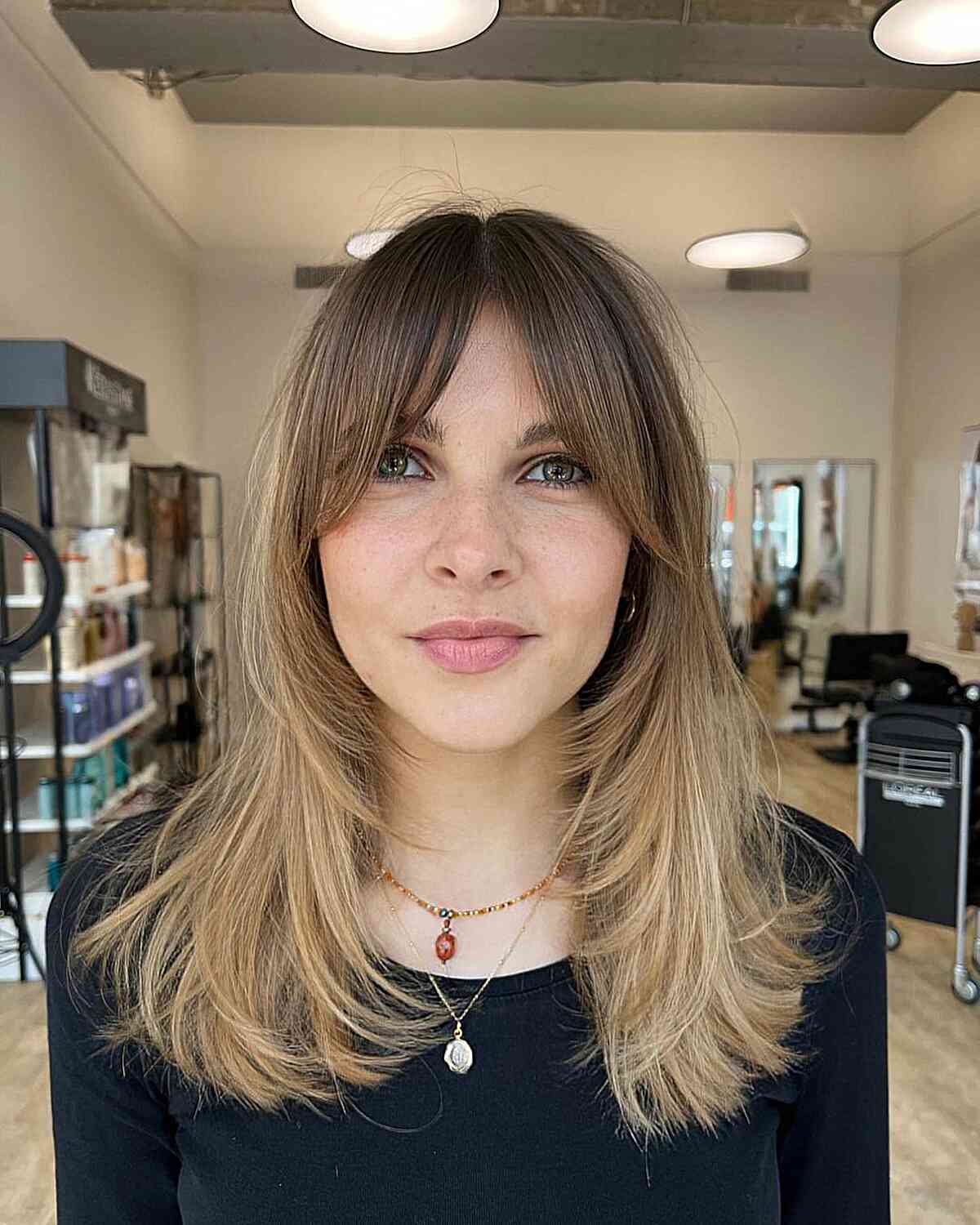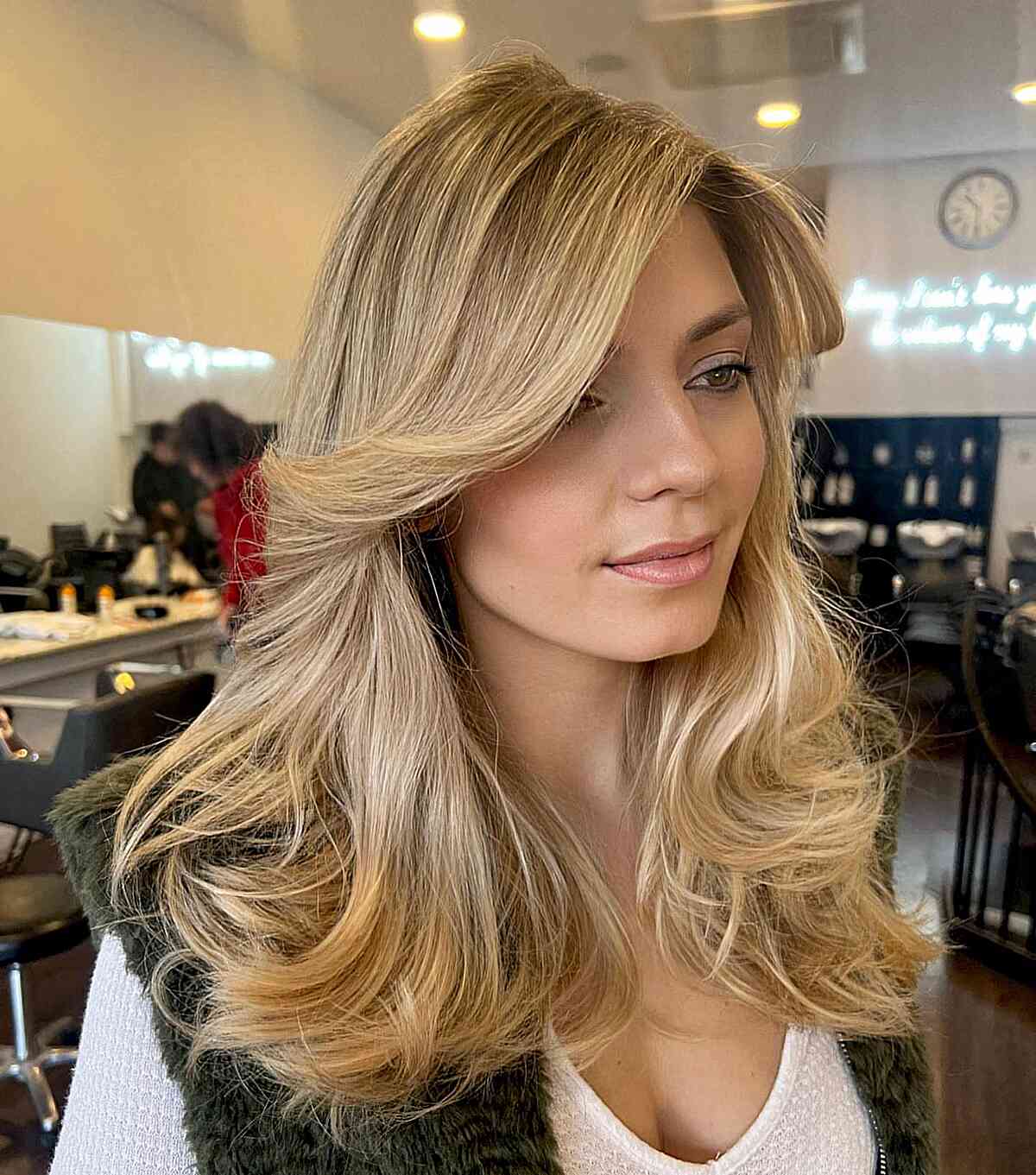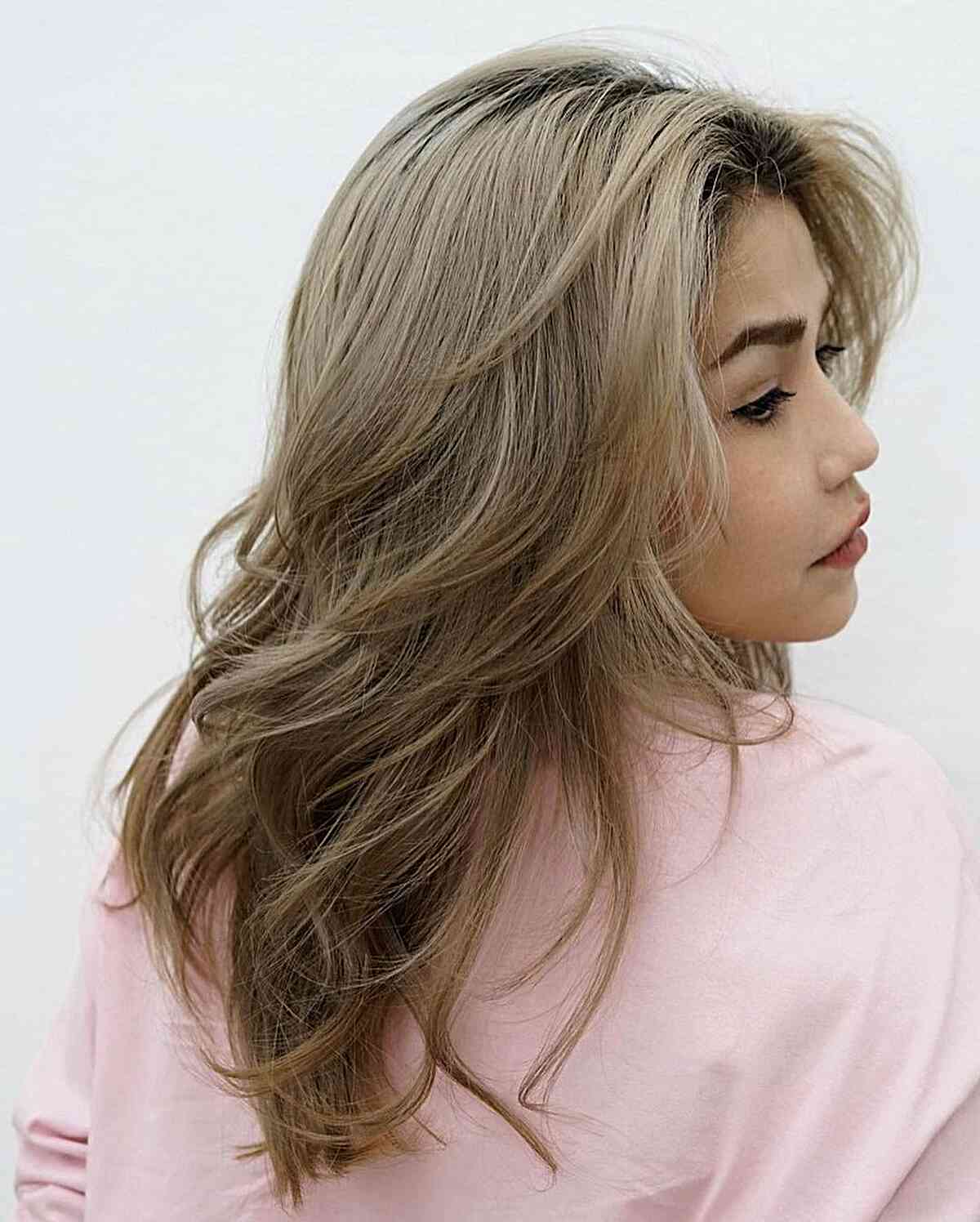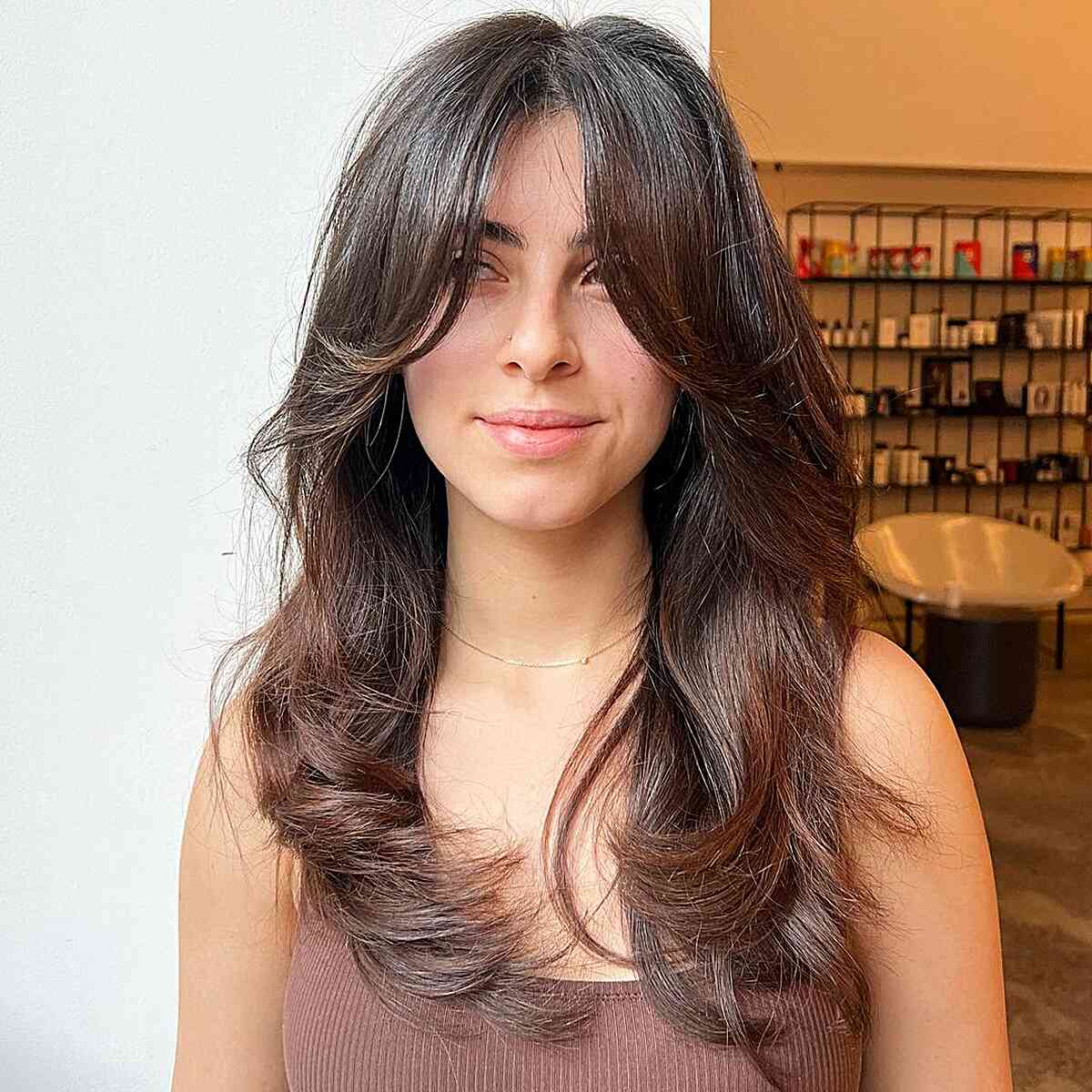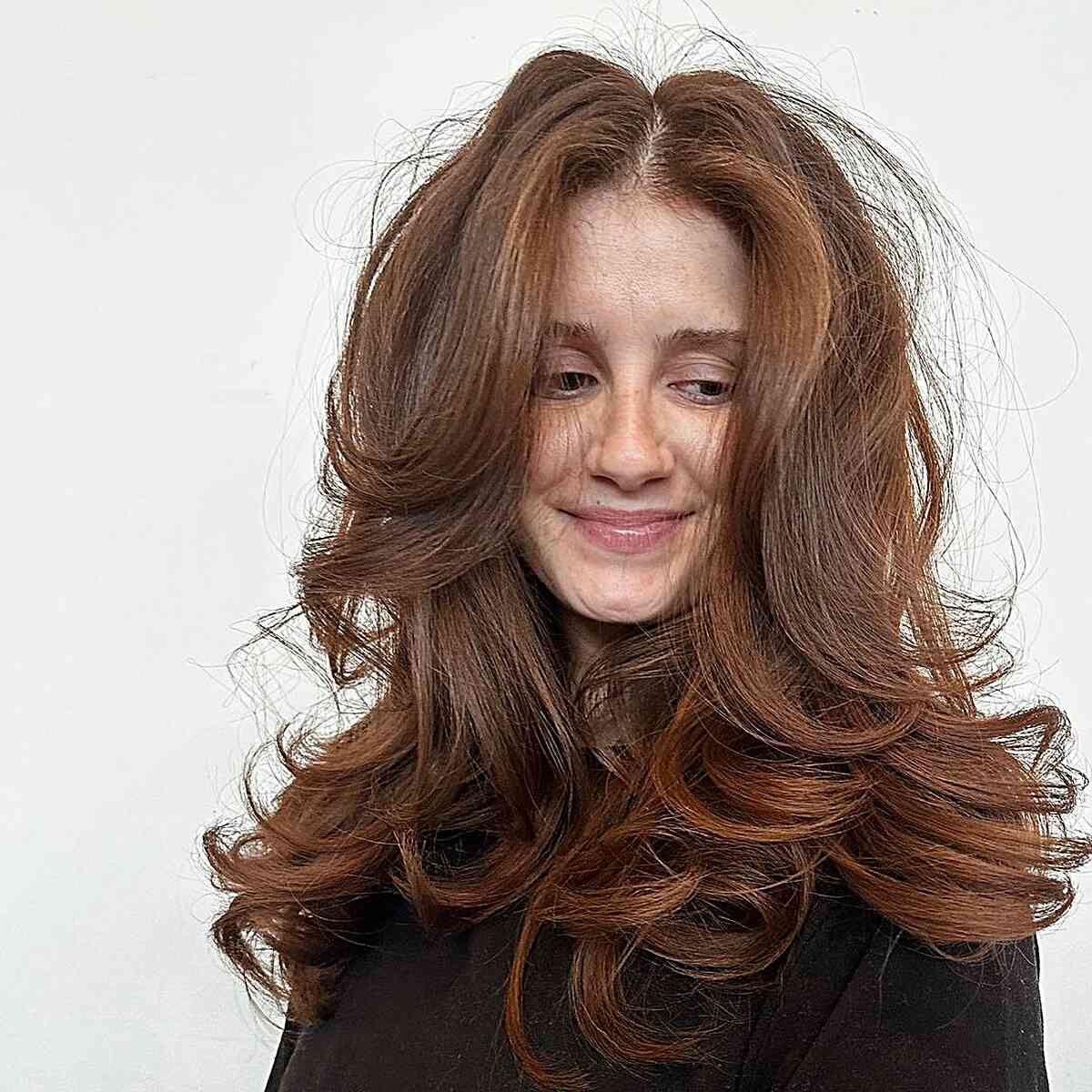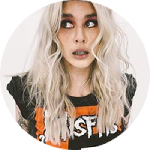#1: Medium to Long Butterfly Layers and Bangs with Money Piece
Try this stunning medium to long butterfly layers look with a money piece! The money piece hair highlight gives you a big color impact, while the layers give you a soft and full texture. Use blow dryer cream to style this look and keep it full and shiny.
#2: Center Parted with Long Layers
A modern shape for long hair is characterized by a center parting with long layers. The draping fringe contributes to the appeal of the center-parted hairstyle. It’s crucial to style your fringe so that it frames your face by flicking away from the cheeks. This will ensure a modern shape that is gorgeous and complementary. Try blowing out your style with a mousse and a medium-sized metal barrel round brush for control and a bit of wave.
#3 Cascading Butterfly Layers with Chestnut Ends
Extra volume and flow define this long butterfly cut with rich chestnut tones. Great for thick, dense hair, the long face-framing layers and flipped ends soften angular features beautifully. The layering starts below the cheekbones and cascades in graduated lengths, giving natural lift without bulk. It’s a flattering choice for oval or heart-shaped faces but may overwhelm finer hair.
#4 Ash Brown Butterfly Layers with Tapered Ends
Understated yet elegant, this ash brown butterfly cut features longer tapering near the collarbone for a sleek finish. Best on straight to slightly wavy hair, the soft layering prevents a blunt look while maintaining fullness. It’s a low-maintenance option for professionals or glasses wearers, though it may lack volume on ultra-fine textures.
#5 Butterfly Chin-Length Layers on Auburn Hair
Rounded and face-hugging, these chin-length butterfly layers on auburn hair bring warmth and lift to medium-density textures. The layers start at the cheeks and curve inward, adding structure to soft facial features. It’s a youthful look, but one drawback—shorter layers can flick outward if not styled daily. Great for square and oval faces needing softness.
#6 Face-Framing Butterfly Cut with Fine Layers
Soft, face-framing layers and warm blonde tones make this butterfly cut incredibly flattering for long faces or finer textures. The layering starts high up, adding movement without sacrificing length. It’s airy and feminine, but because the layers are delicate, this cut may fall flat if your hair lacks volume or wave. Ideal with a light mousse or blowout.
#7 Butterfly Shag with Tousled Texture
Textured and piecey, this butterfly shag has a tousled finish with soft layering throughout. Perfect for long, fine to medium-density hair, it adds fullness and shape without weight. The wispy curtain bangs open up the face, while the ends flip out for a relaxed, modern look. Downside: needs light styling products to maintain texture without frizz or separation.
#8 Mid-Length Butterfly Cut with Chocolate Tones
The chocolate brown tones and seamless layers make this mid-length butterfly cut a low-maintenance classic. The curtain bangs blend into long cheek-hugging layers that soften the face. This cut works great for straight or slightly wavy textures with medium density. Just note: without some styling, the layers can flatten out through the day, especially on straighter hair.
#9 Silver Blend Butterfly Layers with Volume at Crown
This silver butterfly cut has flattering crown lift and soft layering, perfect for mature women embracing their natural grays. The volume at the crown gives the illusion of thicker hair, while the soft waves around the jawline offer lift and balance. It works beautifully on wavy textures with medium to thick density. Downside? The feathered bangs may require regular shaping to avoid looking heavy.
#10 Long Butterfly Cut with Subtle Burgundy Highlights
Dimensional burgundy highlights and soft, cascading layers breathe life into this long butterfly haircut. Ideal for dense, dark hair, it frames the face while keeping fullness through the ends. The subtle red undertones catch the light beautifully. Be aware—this look needs a curling iron or round brush to get the bounce and movement just right.
#11 Butterfly Layers with Wispy Curtain Fringe
Curtain fringe and loose layering add softness and movement to this medium-length butterfly cut. Ideal for finer or straight hair types, the layers are cut to lift around the mid-face and jawline, giving shape without removing fullness. It’s a great way to add interest to otherwise flat hair, though the wispy fringe may require heat styling to avoid separating too much.
#12 Feathered Butterfly Lob on Honey Blonde Hair
Feathered ends and light side-swept bangs make this honey blonde butterfly lob a youthful, easy-to-style option. It works well on medium-density hair and adds body without sacrificing length. The layering is concentrated below the chin, making it flattering for rounder face shapes. One downside—it needs regular blow-drying to maintain the soft flips and definition in the layers.
#13: Golden Blonde Hair with Face-Framing Layers
If you’re loving the butterfly haircut trend, try a golden blonde hair color with face-framing layers.
#14: Voluminous and Thick Hair
If you’re looking to add some serious volume and thickness to your hair, try this voluminous butterfly haircut. This hairstyle is all about creating a full-bodied look. Using strategic layering and weight removal from the sides, the butterfly cut creates a beautiful shape. This shape enhances your natural volume without sacrificing length. Whether your hair is straight, wavy, thin, or thick, this cut can add dimension and movement to your style. The best way to style this look is using a large round brush and finishing with a curling iron to keep the style in place all day.
#15: Long Hair with Flipped-Out Layers
Longer layered hair, flicked outward, creates a light and bouncy style. The outwardly flicked layers are soft, yet they make an impressive style statement. This look is best styled with a big round brush or hot rollers.
#16: Middle Part Hair with Butterfly Cut
Try a middle part with your hair and a butterfly cut. A middle part helps distribute the thickness of your hair evenly, so one side is not heavier.
#17: Soft Messy Butterfly Long Hairstyle
A soft and carefree butterfly haircut works well for natural, wavy hair. To style it, apply a soft curl cream for a tousled yet neat look.
#18: Sun-Kissed Blonde Layered Hair
Sun-kissed blonde layered hair is a great low-maintenance look. The subtle highlights give just enough dimension, and the layers give the hair a lot of movement.
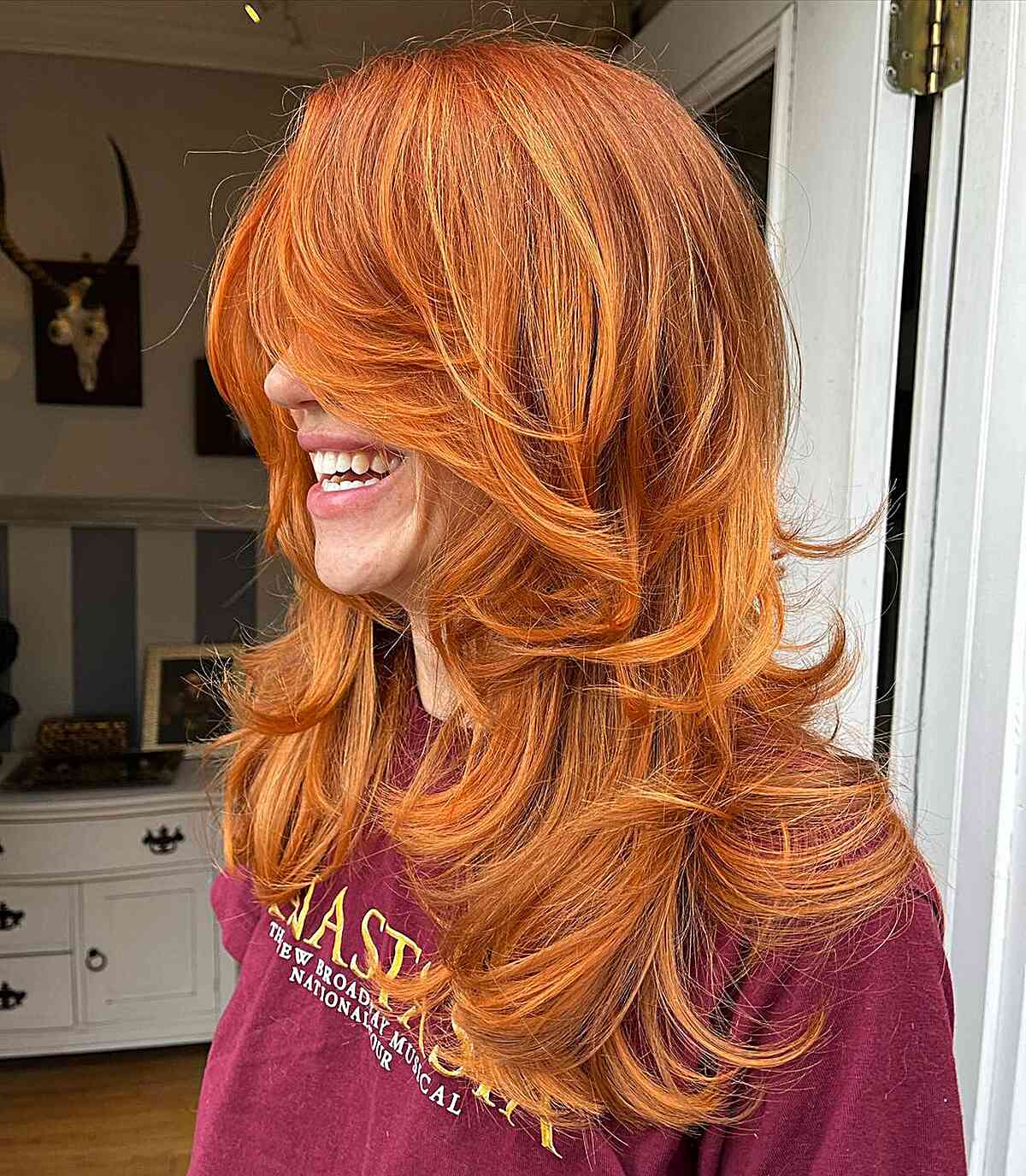
Instagram @clairvoyant.color
#19: Butterfly Layers on Bright Ginger Hair
Adding layers to the bright ginger hair, similar to a butterfly’s wings, helps enhance the hair color. Adding layers of different lengths shows off the hair’s beautiful copper tones.
#20: Chest-Length Butterfly Cut with Wispy Layers
Chest-length hair with a butterfly cut and wispy layers would be a great option for thick hair. These layers will help reduce the heaviness and excess volume for a bouncy and voluminous style.
#21: Low-Maintenance Layered Hair with Long Curtain Fringe
Try low-maintenance layered hair with long curtain fringe if you want the hot new trend. The ‘butterfly cut’ hairstyle is a modern spin on the feather cut made famous by Farrah Fawcett in the 70s. In this style, you have shorter layers around your face and longer ones at the back, which give your hair lots of volume and a bouncy look. Lightening the color at the ends of your hair will bring out the layers even more.
#22: Medium Layered Haircut with Butterfly Wings
A haircut with medium layers, known as the butterfly wings style, has a feminine look. The brushed-back angle around the face resembles butterfly wings. Ask for a layered angle starting at the chin to create softness. Keep minimal layers in the rest of the hairstyle to maintain the length. Style your hair with a metal barrel round brush, working away from your face. Use a 1-inch iron for more waves, and curl your hair in the same direction as your brush strokes.
#23: Layered Short Haircut with Soft Violet Money Piece
Ditch the dead weight with a layered short butterfly haircut and add a soft violet money piece. Short layers will give your hair a lot of movement and lightweight volume. A soft violet money piece gives you a pop of fun around your face and is much easier to maintain than a full head of violet. Keep your violet bright and beautiful! Wash your hair with Celeb Luxury Viral Purple Colorwash Shampoo or Colorditioner Conditioner.
#24: Brunette Hair with Thick Layers
A butterfly cut on thick hair is a great way to keep the layers thick instead of removing a lot of bulk. You can style it to be more full and wavy or wear it more sleek. I recommend using a round brush for a polished look to enhance the layers and embrace your fullness!
#25: Brunette Straight Hair with Butterfly Layers
Ask for a straight brunette hairstyle with butterfly layers. Enhancing your style with soft face-framing layers is simple. Look at your face shape and features, then choose a length that will carve along those features. Butterfly layers will give you an effortless look with softly feathered ends. Style away from the face with your cheek-hugging layers to show off your eyes and cheeks. And soften your jawline with layers that hug around the jaw and neck.
#26: Copper Red Hair with Feathery Layers
Ask for a copper red hair color with feathery layers. A new trendy cut, the butterfly haircut, combines a very layered style with soft, diffused ends. This will create volume in hair that is dense but fine textured. Smooth out this style with a round brush while creating volume in the hair. Hairstory Dressed Up is great for blow drying and locking in your style.
#27: Long Layered Butterfly Cut with Subtle Bangs
Try a long layered butterfly cut with subtle bangs if you want a hot new trend. This haircut will give your hair lots of volume and texture. I recommend getting this haircut if you have a round, oval, or square face shape. I suggest using Kevin Murphy Blow Dry Ever Lift on wet hair to style. Then use a large round brush to blow dry. Use large rollers after your hair is dry for extra lift and body. Finish off with some hairspray, and you’re ready.
#28: Butterfly Curve Cut with Fringe
Try this butterfly curve cut with a fringe. The textured ends give this cut a fluttery and textured vibe!
#29: Shoulder-Length Feathered Cut with Front Layers
Try this feathered cut with front layers if you have or prefer shoulder-length hair. The mix of medium length along with light and airy layers gives this look the most volume. See more feathered cuts for medium-length hair.
#30: Long Layered Wolf Cut for Thin Hair
Try this long layered wolf cut if you have thin hair! The layers on top help give this cut lots of volume and movement. Try and use a good texture spray when styling this cut.
#31: Butterfly-Cut Wavy Hair with Face-Framing Bangs
Try a butterfly cut with wavy hair and face-framing bangs. This look offers length, texture, and overall softness.
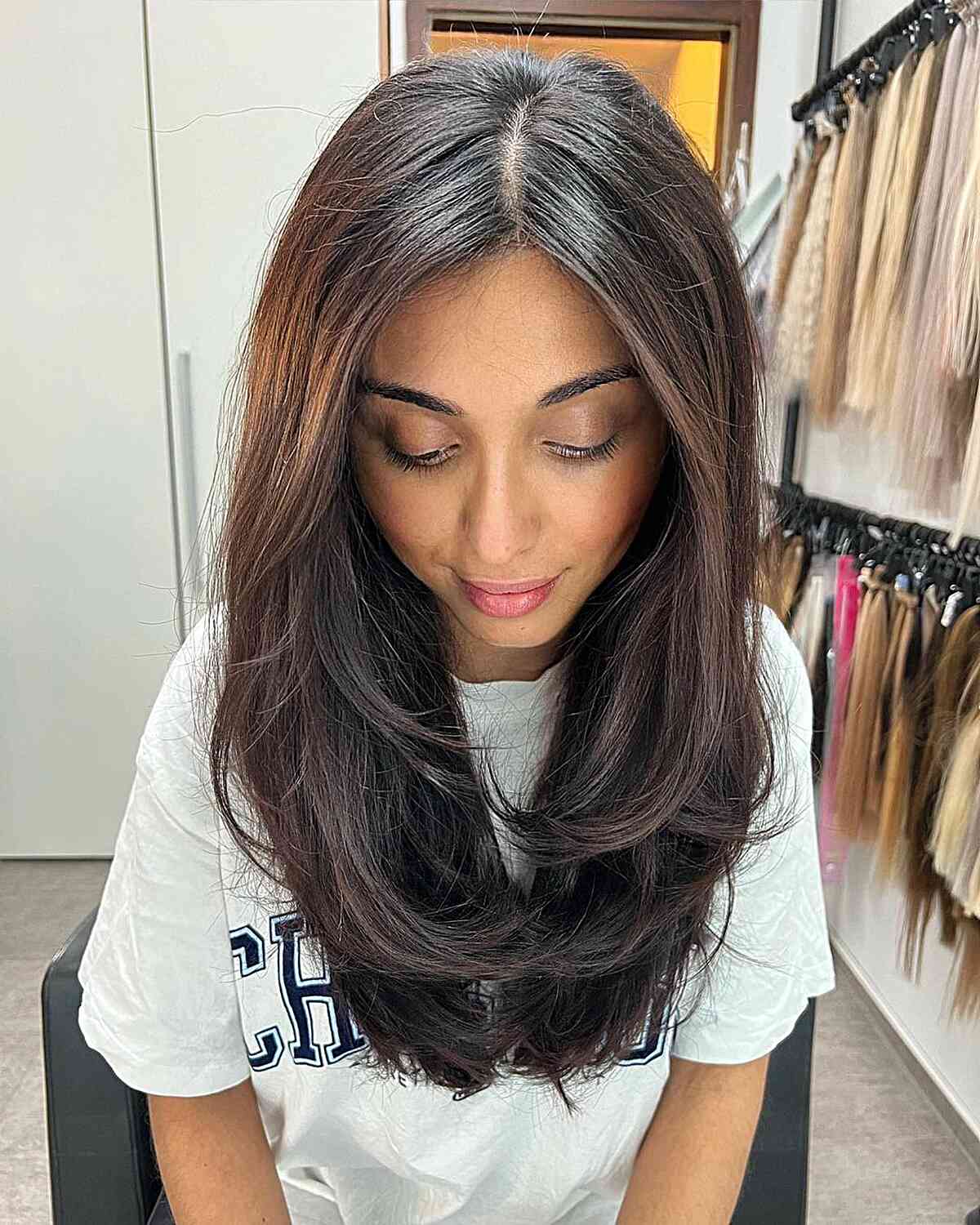
Instagram @stud.io_18
#32: Middle-Parted Haircut
Try this butterfly haircut if you like the middle part. The fluttery layers give this look a soft finish.
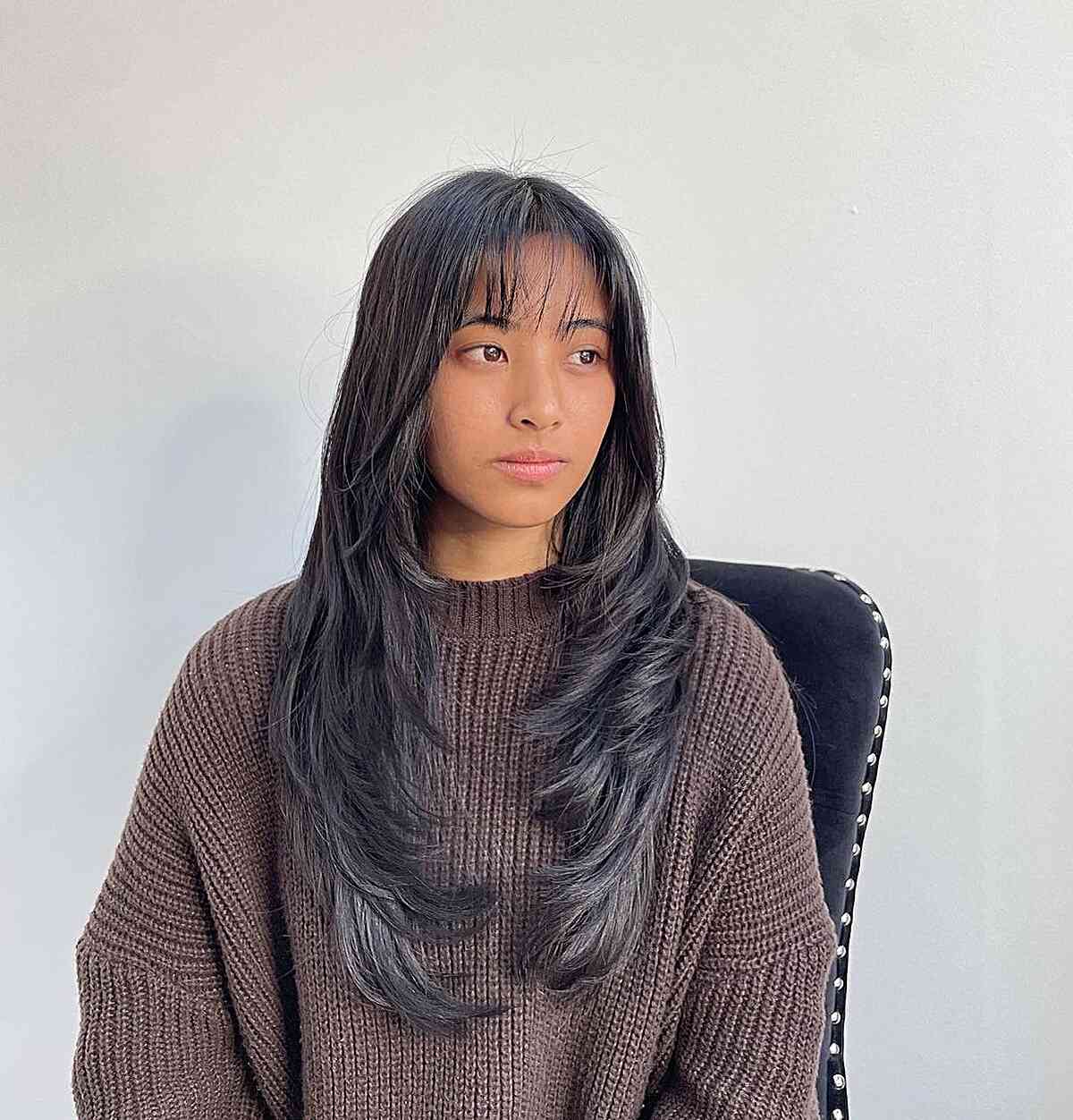
Instagram @hairangel.a
#33: Long Butterfly Cut with Piece-y Bangs
Give this long butterfly cut with piece-y bangs a try! This look has an all-over soft and effortless vibe.
#34: Brown Hair with Bouncy Waves
Styling a butterfly cut with bouncy waves is a great way to add volume and slight texture. This cut gives you a more finished look with very little effort! You can also style this cut in several different ways.
#35: Two-Toned Wolf Cut with Butterfly Layers
The two-toned wolf cut with butterfly layers is a bold and edgy hairstyle. It combines two different hair colors with a trendy cut. The wolf cut features shorter layers in the back and longer layers in the front. This creates a voluminous and textured look. The two-toned color adds a striking contrast and enhances the uniqueness of this hairstyle.
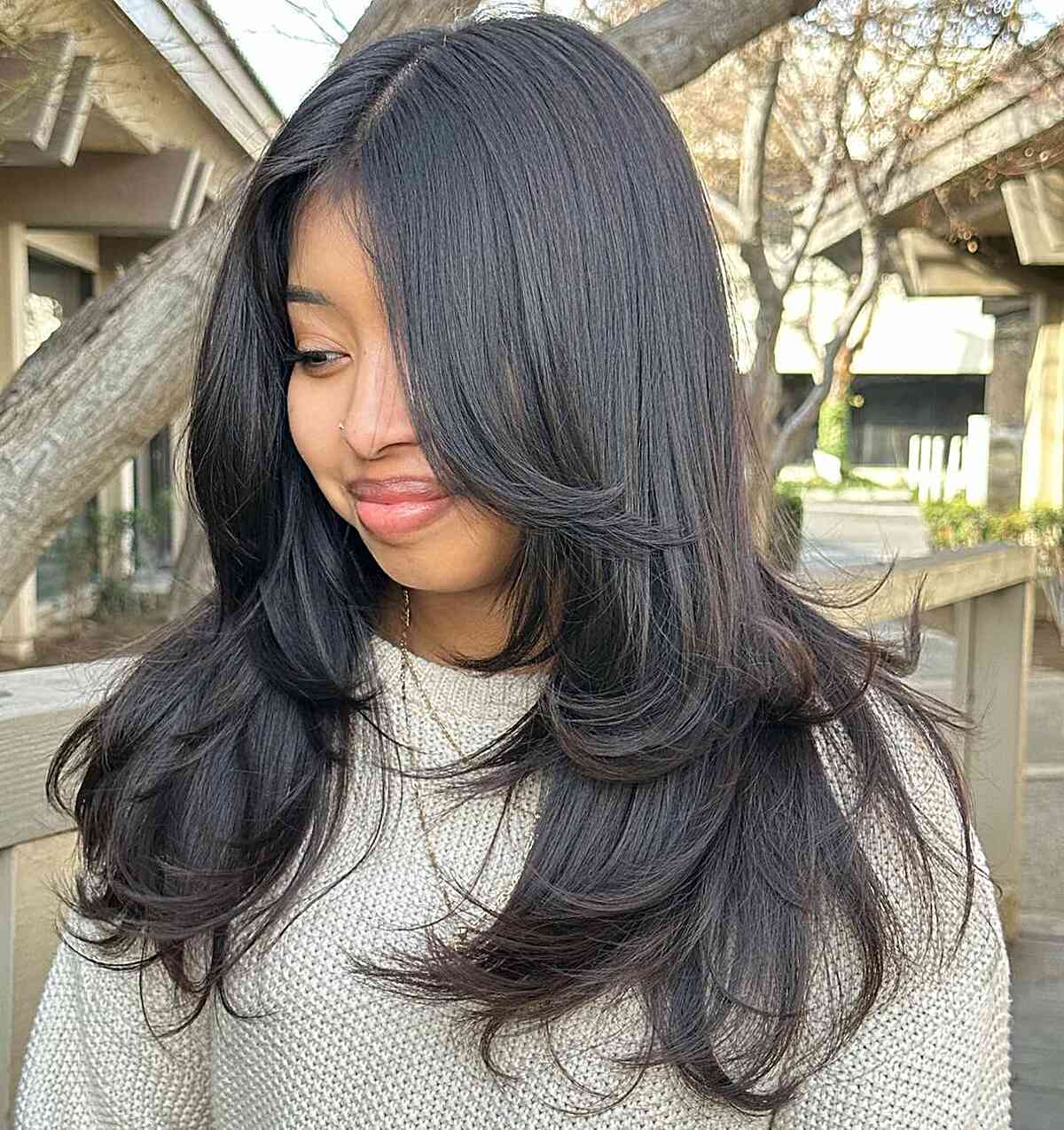
Instagram @hair.by.gabby.g
#36: Fluffy Butterfly Cut with Flicked Ends
Give this fluffy butterfly cut with flicked ends a try! This cut is best if you have fine to medium hair. Be sure to use a good mousse when blow-drying to help those layers pop!
#37: Medium-Length Layered Hair with Face Frame
Try adding some face-framing layers if you want a new medium-length haircut. The face frame gives softness around the face along with volume.
#38: Burgundy Long Layered Cut for Fine Hair
Try this burgundy color with long layers! This cut is best on fine hair. Add a curl to the ends for a fun beach look!
#39: Center-Parted Hair with Long Bardot Bangs
Try this butterfly hair with long Bardot bangs if you like a center part. This is an effortless style with an iconic 70’s vibe!
#40: Layered Octopus Cut with Highlights
The layered octopus cut with highlights is a bold and unique hairstyle. It adds an element of creativity and flair to your look. This cut features multiple layers and textured ends. They resemble the tentacles of an octopus. Adding highlights to this style further enhances its visual appeal. And it creates dimension and depth. When opting for the octopus cut, consulting a skilled hairstylist is essential. They can expertly blend the highlights to complement your hair color and skin tone. They can also recommend maintenance and styling techniques to keep your hair looking fabulous.
#41: Feathery Brunette Hair with Flicks
Try this feathery brunette with hair flicks! This look is best on fine hair, as the flicks help give texture and volume.
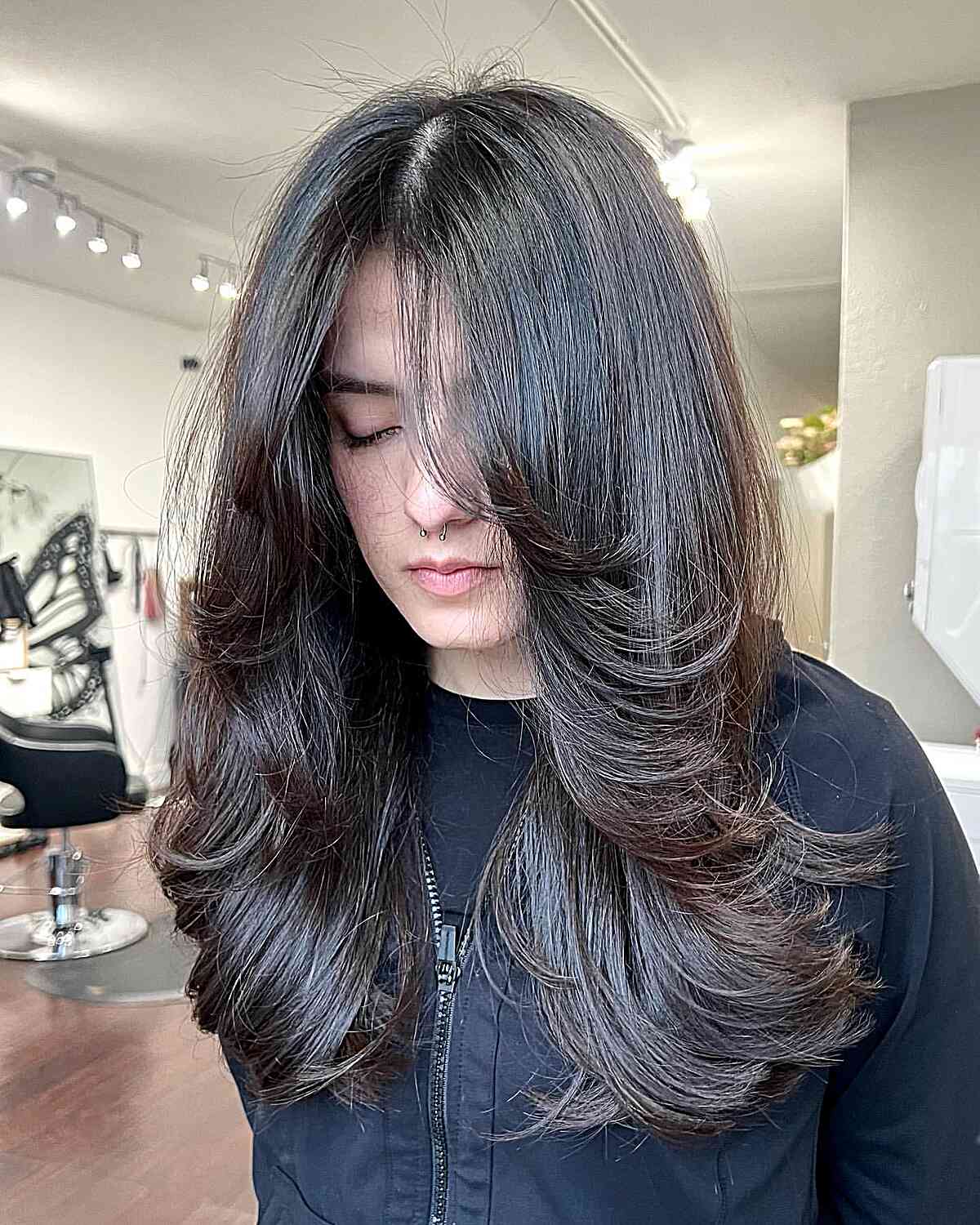
Instagram @hairby.darlene
#42: Face-Framing Blowout Hairstyle
Try this face-framing blowout if you want a bombshell look! This cut will require a good root lifter and volume mousse when styling.
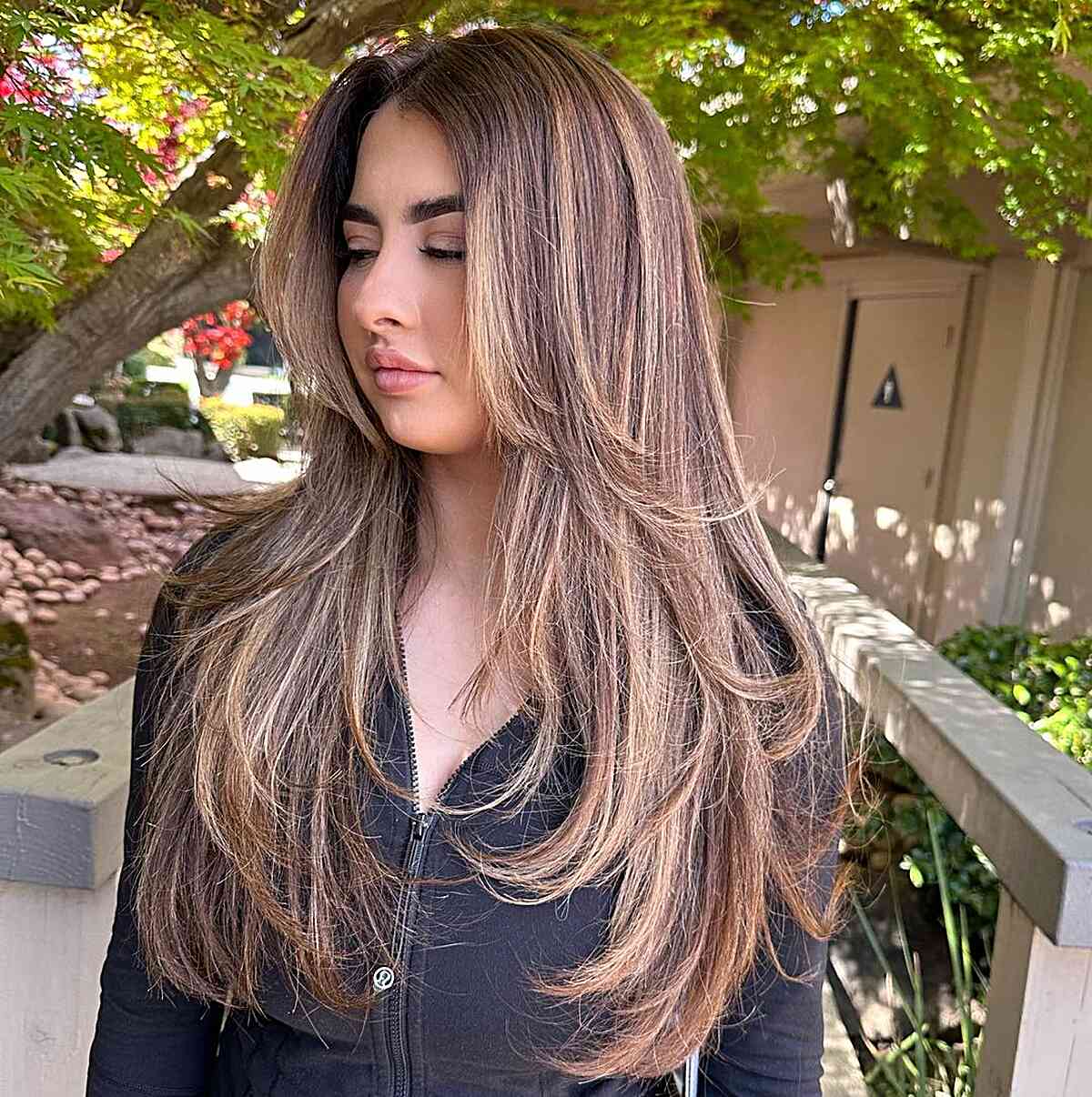
Instagram @hair.by.gabby.g
#43: Dimensional Bronde Hair with Long Layers
Dimensional bronde butterfly hair with long layers is a stunning choice. It combines the best of both worlds! The richness of brunette tones and the vibrancy of blonde highlights. The dimensional effect adds depth and dimension to your hair. It creates a multi-tonal, eye-catching look. The long layers enhance movement and texture. They give your hair a beautiful and flowing appearance. This hairstyle is versatile and flattering, complementing various skin tones and face shapes.
#44: Medium Butterfly Cut with Curtain Bangs
Ask about a medium butterfly cut with curtain bangs. Spice up your style with some curtain bangs that accentuate the cheekbones and eyes. A modern twist to layering the hair is with soft, textured ends. They create an effortless, moveable look. You create a feminine shape with butterfly layers that suit thick hair textures.
#45: Voluminous Butterfly Blonde Hair
This voluminous butterfly blonde is gorgeous! This look has tons of dimensions. Be sure to use a texture cream or spray to keep as much hair texture as possible.
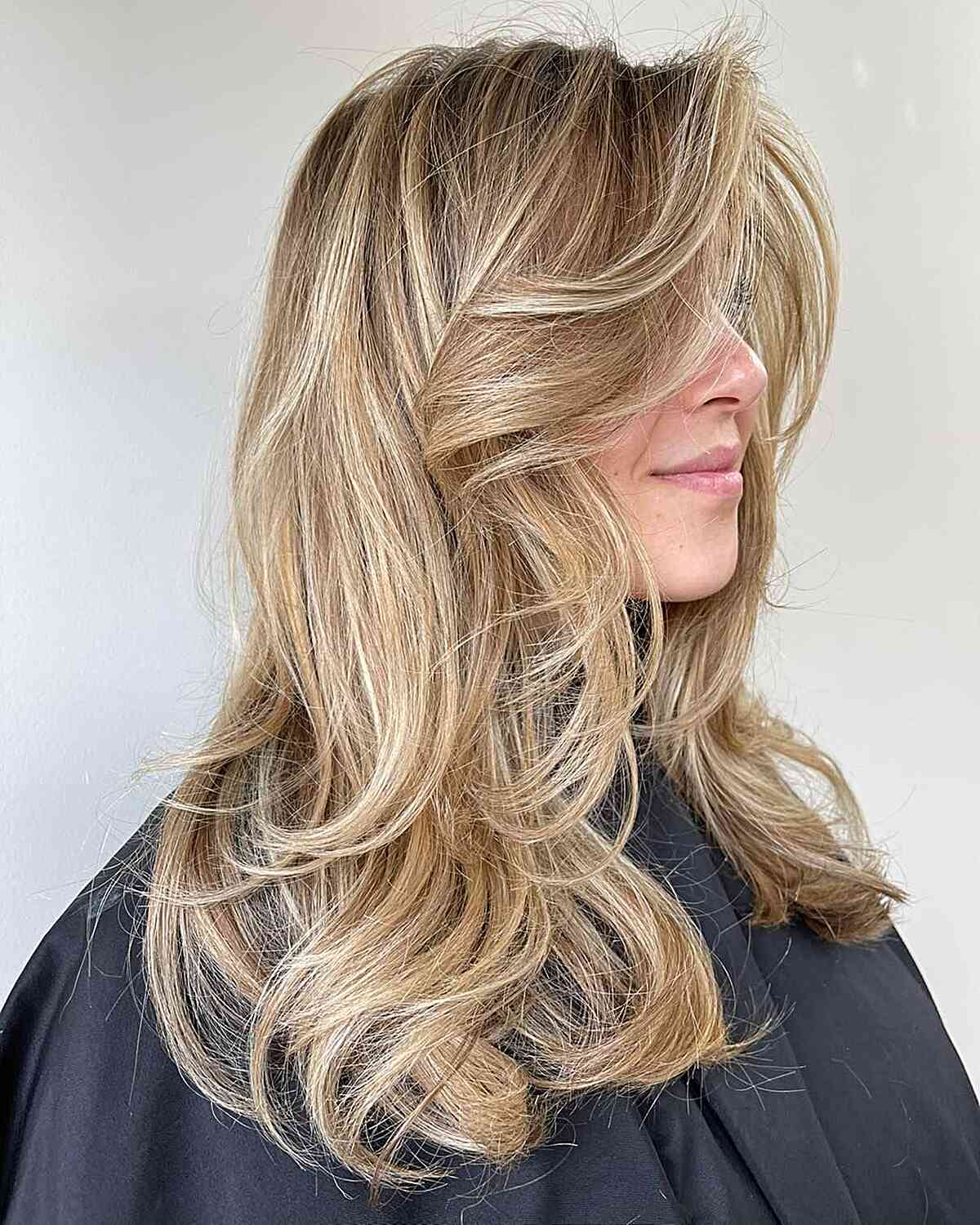
Instagram @bellaria.hairandbeauty
#46: Multi-Layered Cut with Balayage Highlights
Try this multi-layered butterfly hair with balayage highlights. The highlights give this look the illusion of a beautiful butterfly wing. Light, airy, and stunning!
#47: Layered Wavy Black Hair with Face Frame
Try this layered wavy black hair with face frame layers. Be sure to use a texturizing spray to enhance your layers. The face frame layers give this look soft movement.
#48: Medium Blonde Haircut with Soft Layers
Try this medium blonde haircut with soft layers. The layers add movement and keep this look on trend!
#49: Face-Framing Butterfly Cut with Flipped Ends
Give this face-framing butterfly cut with flipped ends. This cut is versatile and will suit different face shapes and hair. Talk with your stylist at your next salon visit to see if this look is an option.
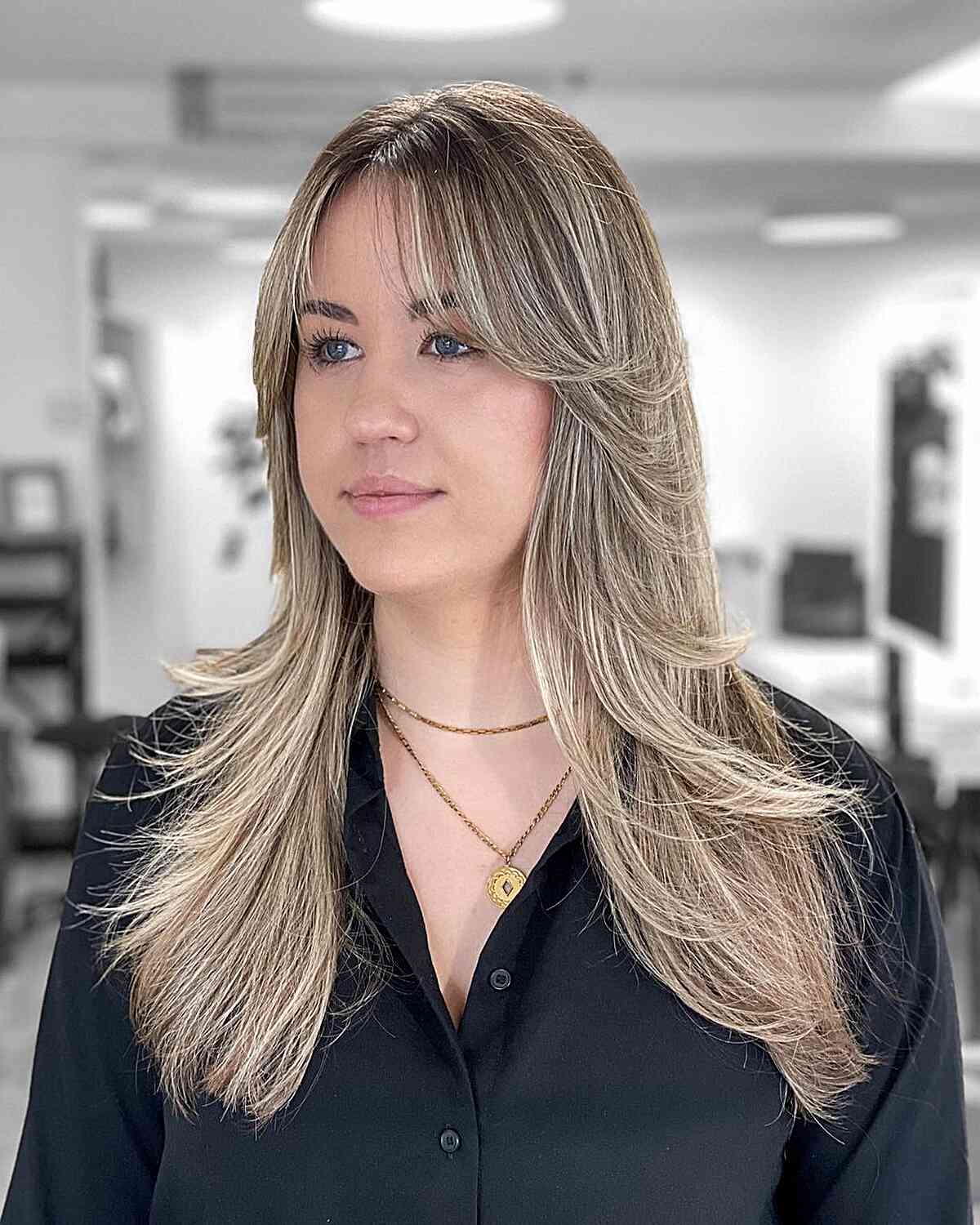
Instagram @thecolorist.ch
#50: Butterfly Layered Cut with Curtain Bangs
Try this butterfly layered cut with curtain bangs! This look offers tons of volume for a trendy shape.
#51: Tousled Face-Framing Layered Haircut
Try this tousled face-framing layered haircut if you have fine hair! The all-over layers create maximum volume and texture.
If you’ve been eyeing the trendy butterfly haircut, you may wonder how it would work with your specific hair type and face shape. Cori McCann, a skilled stylist, shares her expertise and experience, offering valuable insights and tips. In this interview, she breaks down the haircut by hair texture and thickness as well as major face shapes while also providing styling advice and product recommendations to suit various lifestyle types.
Most photos you’ll find online feature a specific hair length and texture. The cut was initially designed for longer hair with straight texture, but that doesn’t mean it can’t be adapted for other lengths and textures. As a stylist, it’s essential to translate the desired look into a haircut that best suits the client’s current hair and lifestyle.
According to McCann, a few modifications can make the butterfly cut work for different hair lengths and textures. It often involves adjusting the layering length to accommodate the client’s hair length. Therefore, if you’re considering this haircut, have an open conversation with your stylist to discuss how to customize it according to your specific hair and preferences.
The butterfly cut, similar to the shag, can accentuate bone structure through its layering technique. The flexibility of the cut allows stylists to customize the layering points, making it suitable for every face shape. McCann compares the process to using makeup or color techniques to highlight or contour bone structure. Just as makeup enhances facial features, haircuts, and color can serve the same purpose.
McCann suggests focusing the layering points at the cheekbones or jawline to highlight your natural bone structure. Choosing where the layering begins can impact how your hair frames your face. For instance, starting the layering at the cheekbones results in a few pieces falling around your face when you pull your hair back while layering beginning at the jawline allows you to tuck your hair behind your ears without any hair escaping around your face.
Styling plays a crucial role in achieving the desired look with the butterfly cut. While the shape of the cut will be present regardless of styling, it won’t have the same impact without proper styling techniques. McCann recommends a specific styling method to enhance the sweeping layers resembling butterfly wings.
To style the butterfly cut, section your hair into a mohawk section along your part. Using either a blowdryer and round brush or a large barrel curling iron, direct each subsection up and away from your face. As you work your way backward, pin each section up, allowing the hair time to cool and set. By directing the hair backward and setting it, you create volume at the root and isolate the layers, making them more prominent in the finished style.
When it comes to product recommendations, McCann suggests different options depending on your hair type. For fine hair, a lightweight mousse like Neuma’s Neu Styling Mousse can provide volume and hold. Clients with naturally textured or thick hair may benefit from R&Co’s High Dive, which helps smooth and add shine. Regardless of hair texture or density, McCann highly recommends Neuma’s NeuMoisture Instant Fix as a foundation for any hair type. This product not only has essential styling benefits but also provides heat protection to keep your hair healthy, no matter how you choose to style it.

